Last Updated on August 23, 2023 by Amanda P. Brown
When it comes to the world of fruits, those fruit that start with “B” bring a burst of flavors, colors, and nutrients to our tables. From the beloved babaco to the antioxidant-rich blueberry and the juicy blackberry to the tropical beauty of the pineapple-like barbadine, “B” fruits offer a diverse range of tastes and health benefits.
Let’s explore these delicious and healthy delights that satisfy our taste senses and improve our health.
32 Fruit That Start With B
Table of Contents
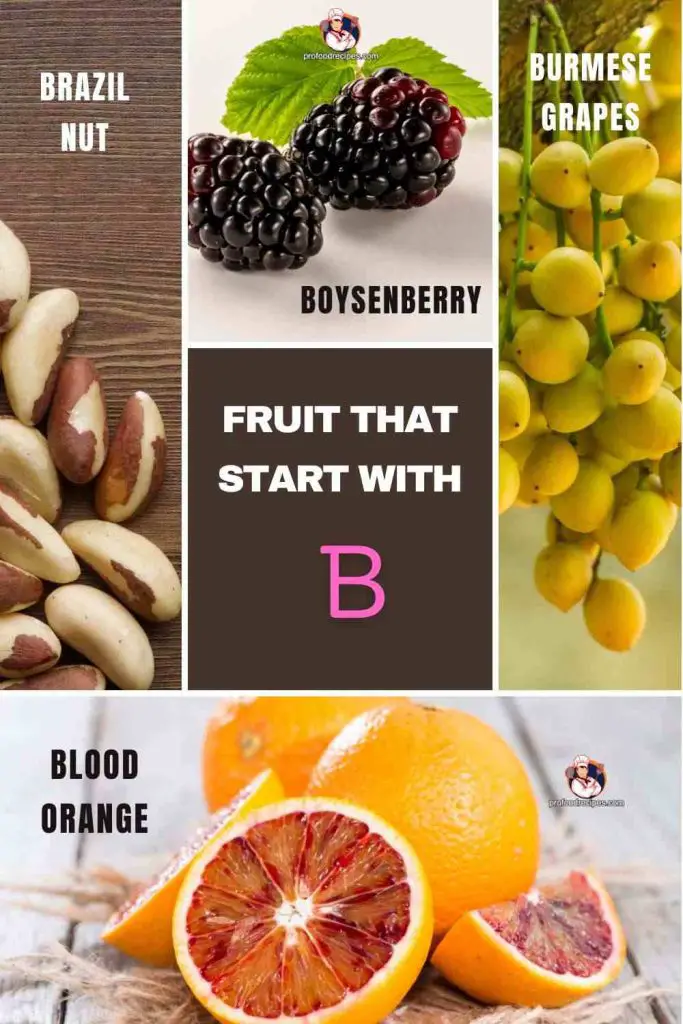
- Boysenberry
- Brazil nut
- Barbadine
- Batuan
- Blackberry
- Blood orange fruit
- Babaco fruit
- Bacuri fruit
- Bitter melon
- Bael fruit
- Ballon berry
- Balsam apple
- Banganapalle mango
- Baobab fruit
- Barbados cherry
- Bayberry
- Beach plum
- Betel nut
- Bilberry
- Bilimbi
- Black mulberry
- Black sapote
- Blackcurrants
- Bolwarra
- Brazilian guava fruit
- Burmese grapes
- Breadfruit
- Bolivian mountain cocounut
- Bignay
- Bush butter fruit
- Broadleaf bramble fruit
- Blue tongue fruit
1. Boysenberry
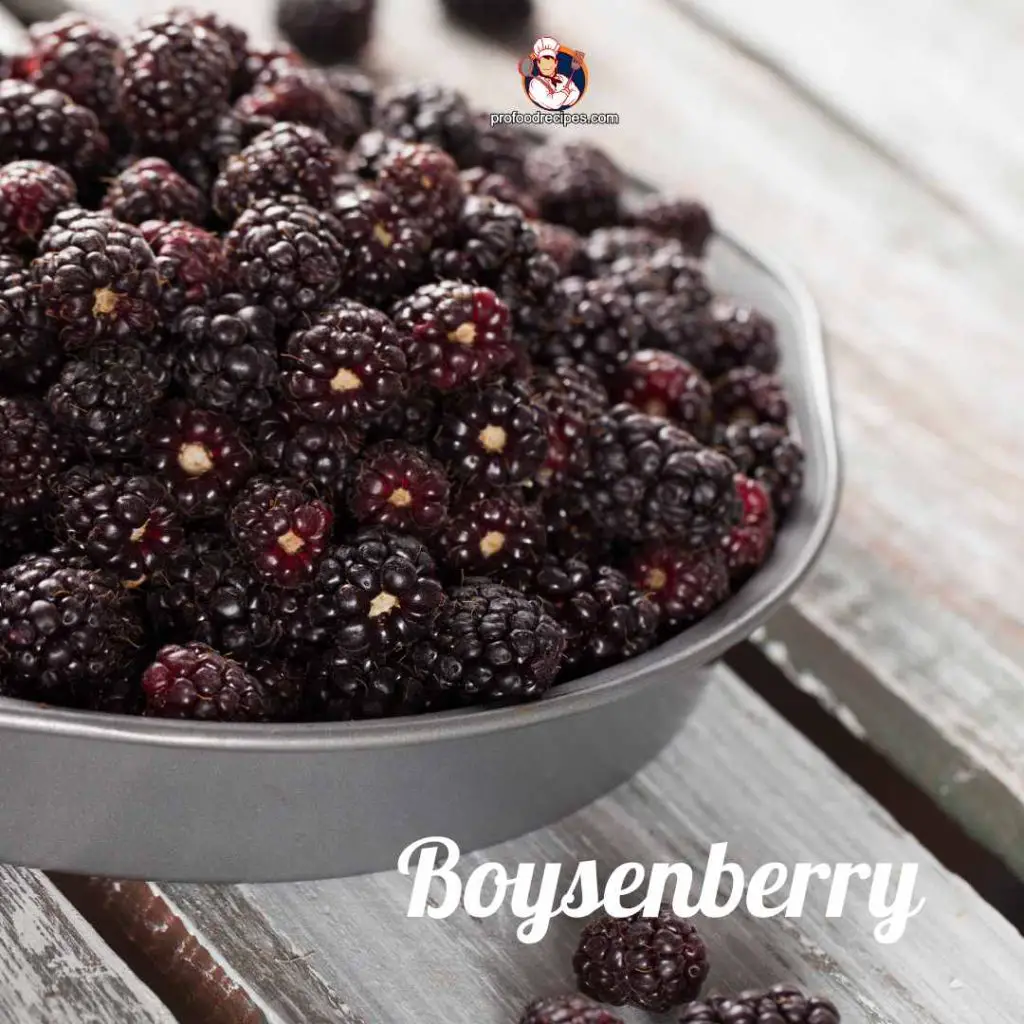
Boysenberries, a fruit starting with b, thrive in New Zealand and the Pacific Northwest on vine plants. Combining the juiciness of blackberries and the sweetness of raspberries, they’re transformed into syrup for pancakes or smoothies and enhance baked goods.
Packed with antioxidants, fiber, vitamins, and minerals, boysenberries support heart, digestion, and lung health while combating oxidative stress.
| Nutrition | Quantity |
| Calories | 43 |
| Carbohydrates | 9.61g |
| Dietary Fiber | 5.3g |
| Sugars | 4.88g |
| Vitamin C | 21.0mg (35% DV) |
| Vitamin K | 19.8µg (25% DV) |
| Folate | Small Amount |
| Potassium | Small Amount |
| Calcium | Small Amount |
| Iron | Small Amount |
| Magnesium | Small Amount |
2. Brazil Nut
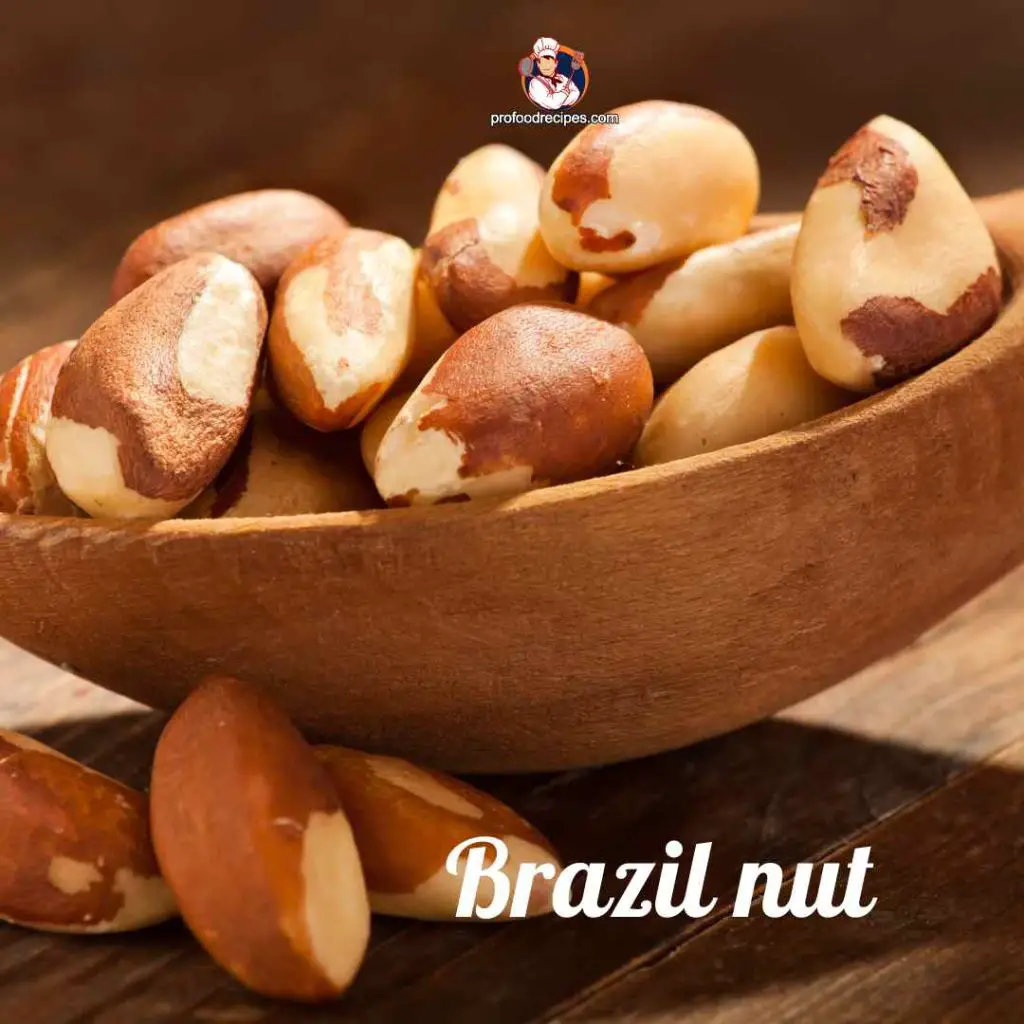
Named for Brazil, the Brazil nut is a seed, not a nut. It’s an excellent source of protein, vitamins, minerals, and healthy fats, among fruits that start with the letter B. Its high selenium content makes it an excellent antioxidant that benefits the thyroid, heart, and brain.
With a buttery, nutty flavor and a dense, crunchy texture, Brazil nuts are versatile, enhancing raw and roasted dishes. They are also minced and added to salads and other dishes.
| Nutrition | Quantity |
| Calories | 656 |
| Carbohydrates | 12.3g |
| Dietary Fiber | 8.5g |
| Sugars | 2.3g |
| Protein | 14.3g |
| Fat | 66.4g |
3. Barbadine
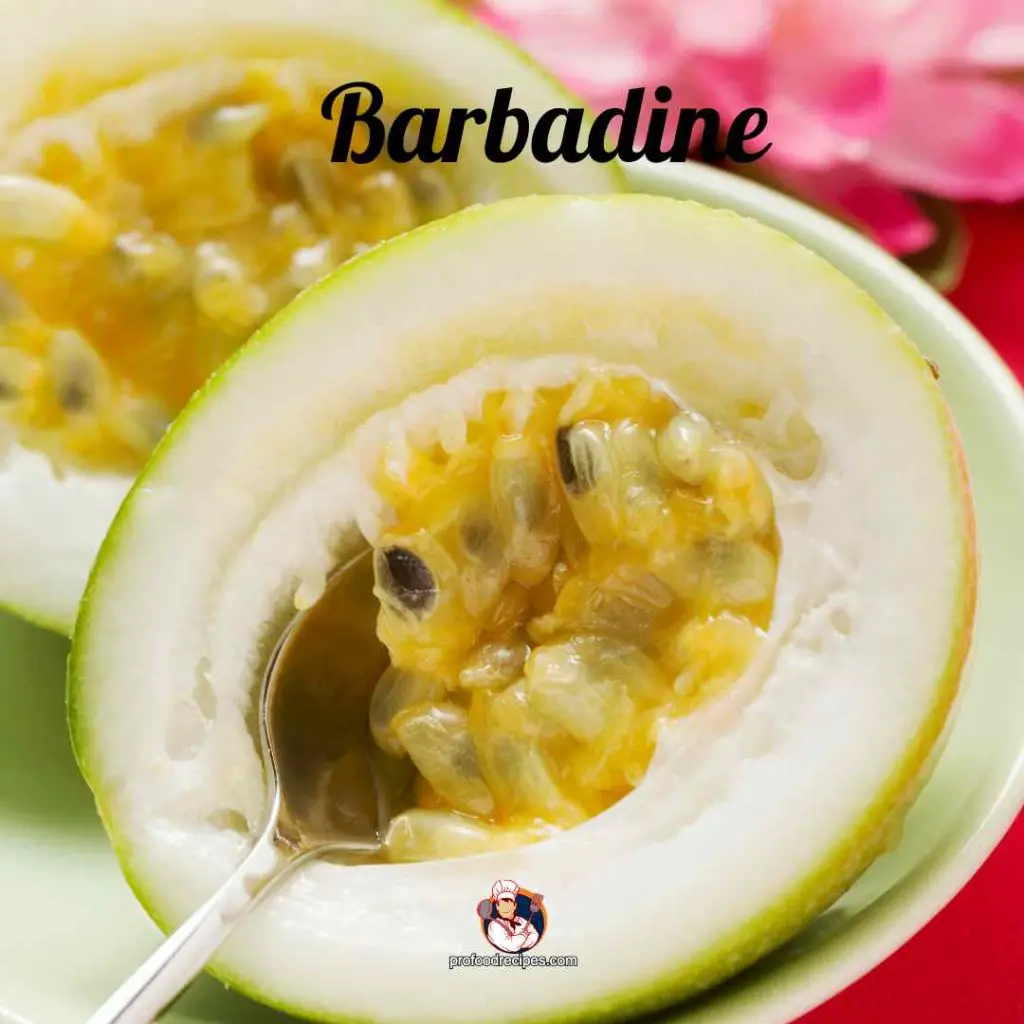
Barbadine, also called sweet granadilla or grenadia (Passiflora ligularis), originates from the Passiflora genus. Its large, green-skinned fruit turns yellow when ripe. Soft, creamy flesh holds small seeds with a sweet, floral taste.
As a result of its high levels of vitamins A and C, fiber, and antioxidants, it promotes healthy digestion, immunity, and skin. Enjoyed fresh, as juice, ice cream, and even cooked as curry in Sri Lanka.
| Nutrition | Quantity |
| Calories | 97 kcal |
| Carbohydrates | 23 g |
| Dietary Fiber | 10 g |
| Sugars | 13 g |
| Protein | 2 g |
| Fat | 0.4 g |
| Calcium | 9 mg (1% of the Daily Value) |
| Potassium | 496 mg |
| Iron | 1.6 mg (9% of the Daily Value) |
4. Batuan
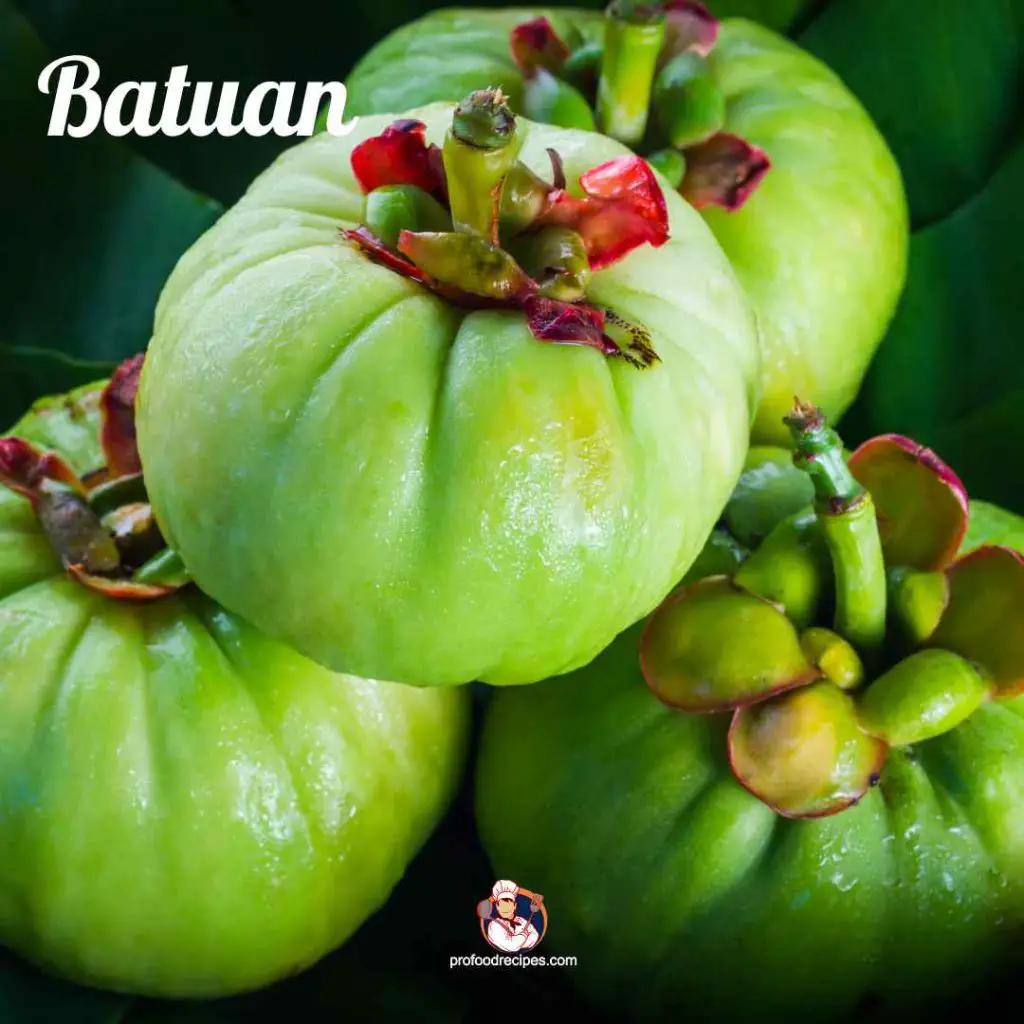
Batuan fruit, similar to tomatoes in size, boasts green flesh, thriving in the Philippines. With a tangy yet non-acidic sourness, it’s a common souring agent in various dishes and sauces. Its distinct flavor enriches soups and native delicacies.
Besides culinary versatility, it provides antioxidants, supports cholesterol reduction, boosts immunity, and delivers vitamin C for optimal health.
| Nutrition | Quantity |
| Calories | 70-80 kcal |
| Carbohydrates | 18-20 g |
| Fat | 0.5-1 g |
| Protein | 1-2 g |
| Dietary Fiber | 4-6 g |
| Sugars | 8-10 g |
| Vitamin C | 20-30 mg |
| Calcium | 10-15 mg |
| Potassium | 150-200 mg |
5. Blackberry
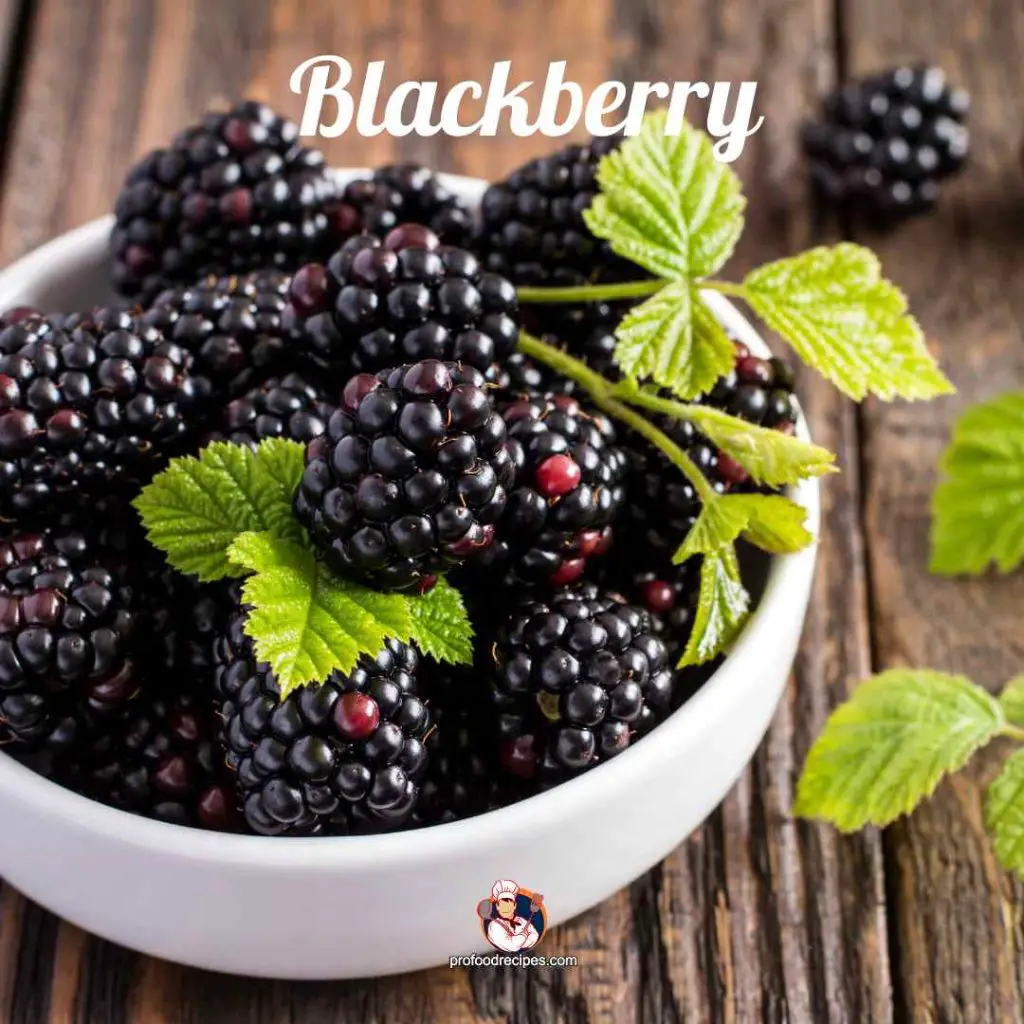
Blackberries, produced from the bramble plant, are found worldwide except Antarctica. This fruit looks purple-black and has a mouthwatering and tart flavor when red and bitter as unripe.
However, this juicy fresh berry is packed with fiber, vitamin C, and vitamin K, which support weight and cholesterol control, immunity, and heart health. Moreover, these delicious fruits that start with B make a great addition to jelly, crisps, crumbles, pies, muffins, jams, or other sweet delights.
| Nutrition | Quantity |
| Calories | 43 kcal |
| Carbohydrates | 9.6 g |
| Dietary Fiber | 5.3 g |
| Fat | 0.4 g |
| Protein | 1.3 g |
| Calcium | 29 mg |
| Sugars | 4.5 g |
6. Blood Orange Fruit
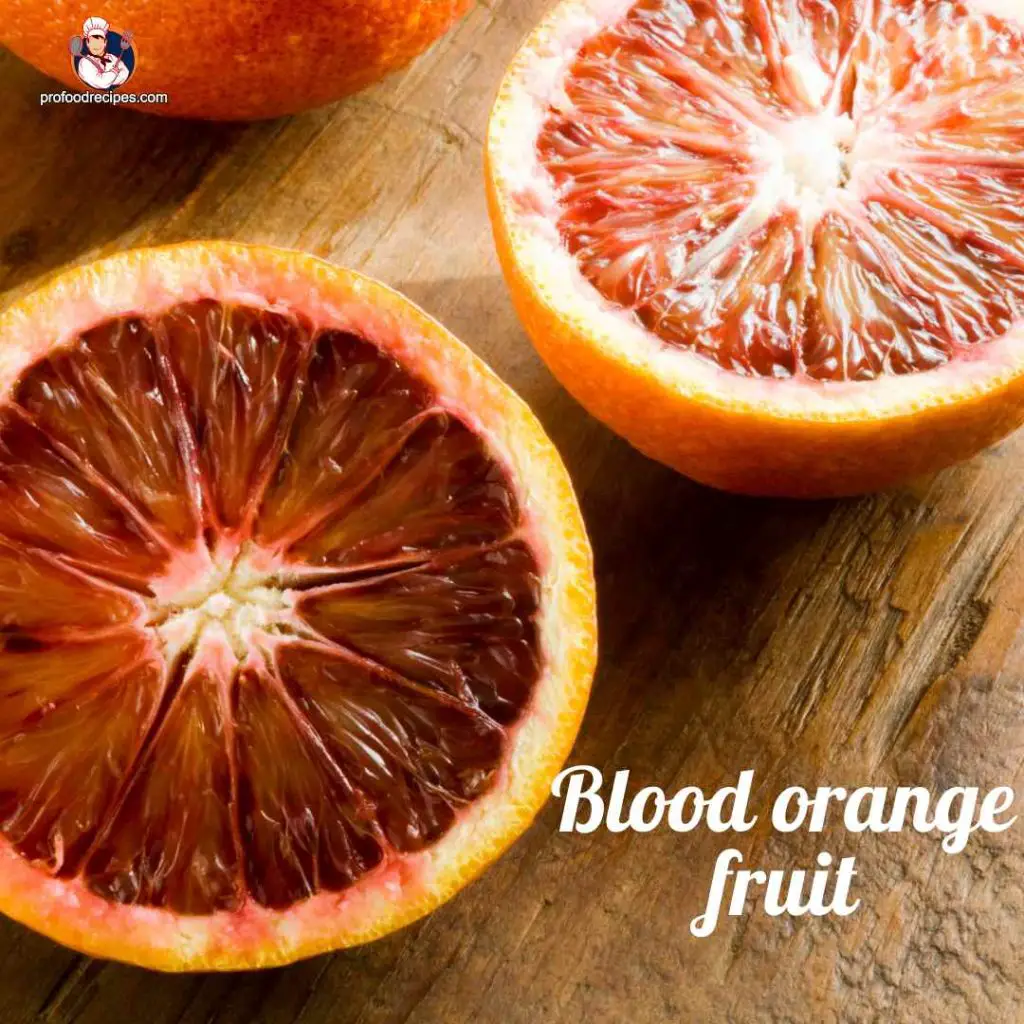
Blood oranges stand apart from regular oranges with their deep red-purple flesh and juice resulting from polyphenol antioxidants. Less acidic and sweeter than navel oranges, they carry raspberry and strawberry hints.
Available from November to May, these fruits are vitamin C and fiber-rich, supporting gut health, immunity, and weight loss. They also belong to the ‘fruits with B’ category, alongside bananas, blueberries, and blackberries. Enjoy them fresh or incorporate them into dishes, drinks, and desserts.
| Nutrition | Quantity |
| Calories | 43 kcal |
| Carbohydrates | 8.3 g |
| Dietary Fiber | 2.0 g |
| Sugars | 6.2 g |
| Fat | 0.2 g |
| Protein | 0.9 g |
| Calcium | 40 mg |
| Potassium | 181 |
7. Babaco Fruit
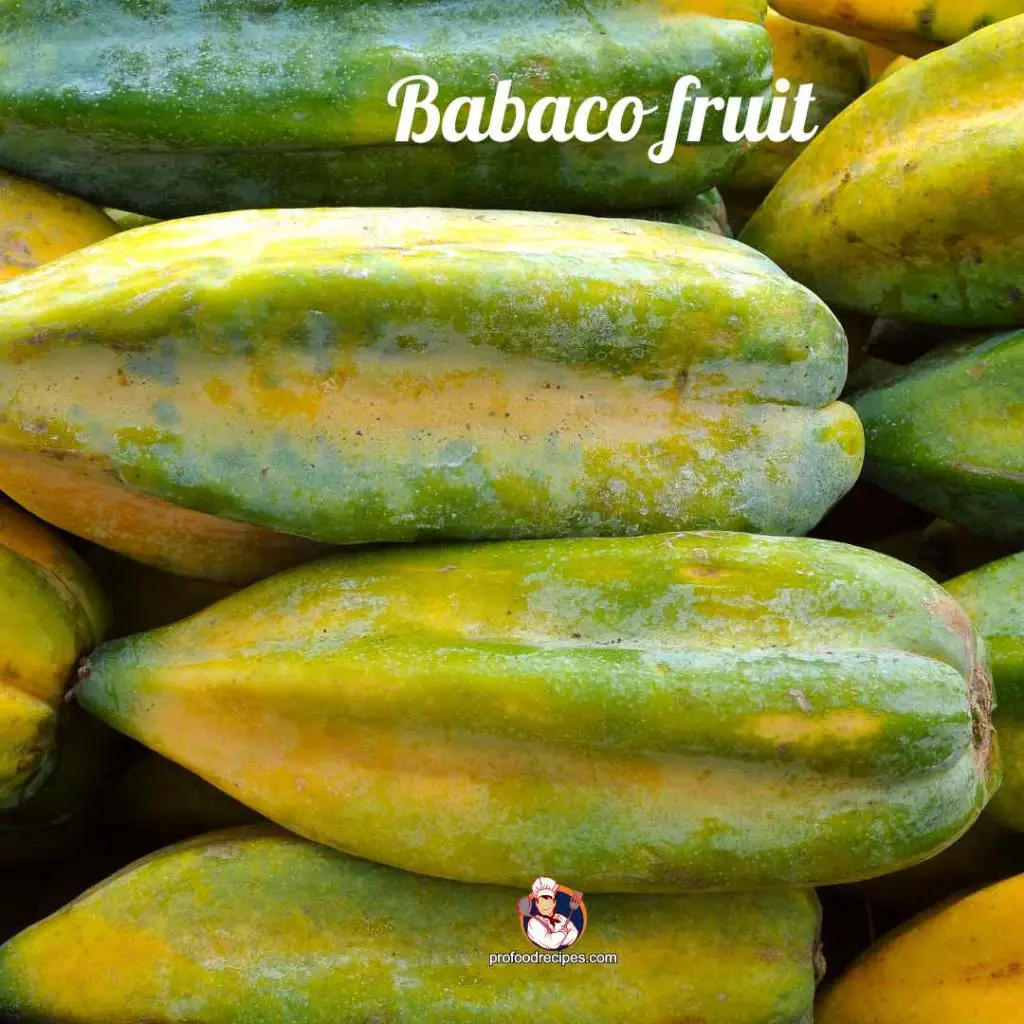
Babaco is a tropical fruit derived from Ecuador. It offers abundant potassium for enhanced cognitive function, brain oxygenation, and skin infections treatment. This fruit resembles papaya but is considerably thinner.
And it has seedless with a thin edible skin and a sweet flavor resembling a pineapple and strawberry. However, they are great added to smoothies or desserts as a garnish.
| Nutrition | Quantity |
| Calories | 35 kcal |
| Carbohydrates | 8.9 g |
| Dietary Fiber | 2.1 g |
| Sugars | 5.7 g |
| Fat | 0.1 g |
| Protein | 0.5 g |
| Calcium | 8 mg |
| Magnesium | 8 mg |
| Potassium | 260 mg |
| Folate | 12 µg (3% of the Daily Value) |
| Vitamin C | 80 mg (133% DV) |
| Vitamin A | 240 (5% DV) |
8. Bacuri Fruit
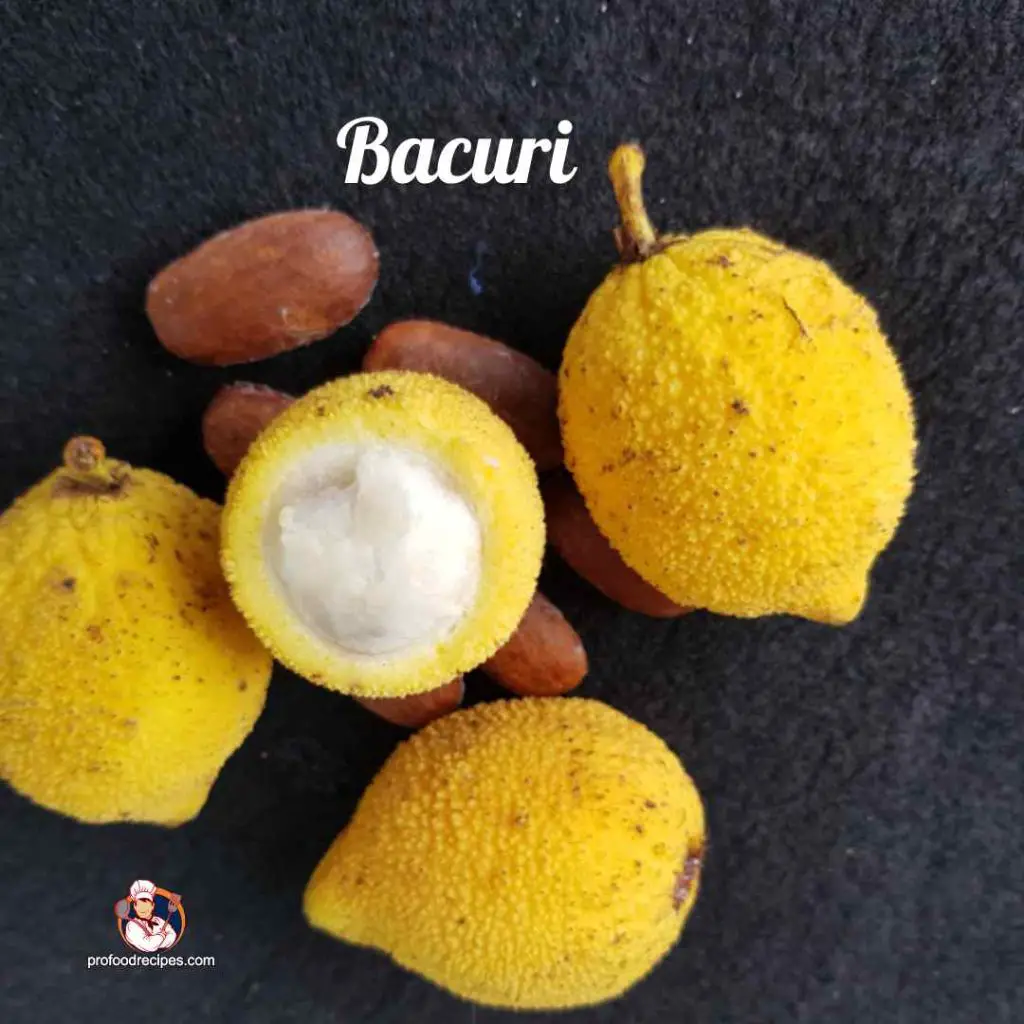
Bacuri is referred to by its scientific name, platonia. It is largely from the Amazon rainforest. It is an orange-shaped fruit with a sweet and acidic pulp that is sticky.
They can be eaten raw or pickled and are frequently used in desserts such as ice cream and jam. On the other hand, this fruit is high in vitamins and antioxidants, which help with immunity and skin health.
| Nutrition | Quantity |
| Calories | 50g |
| Carbs | 11g |
| Fat | 1g |
| Protein | 0g |
9. Bitter Melon
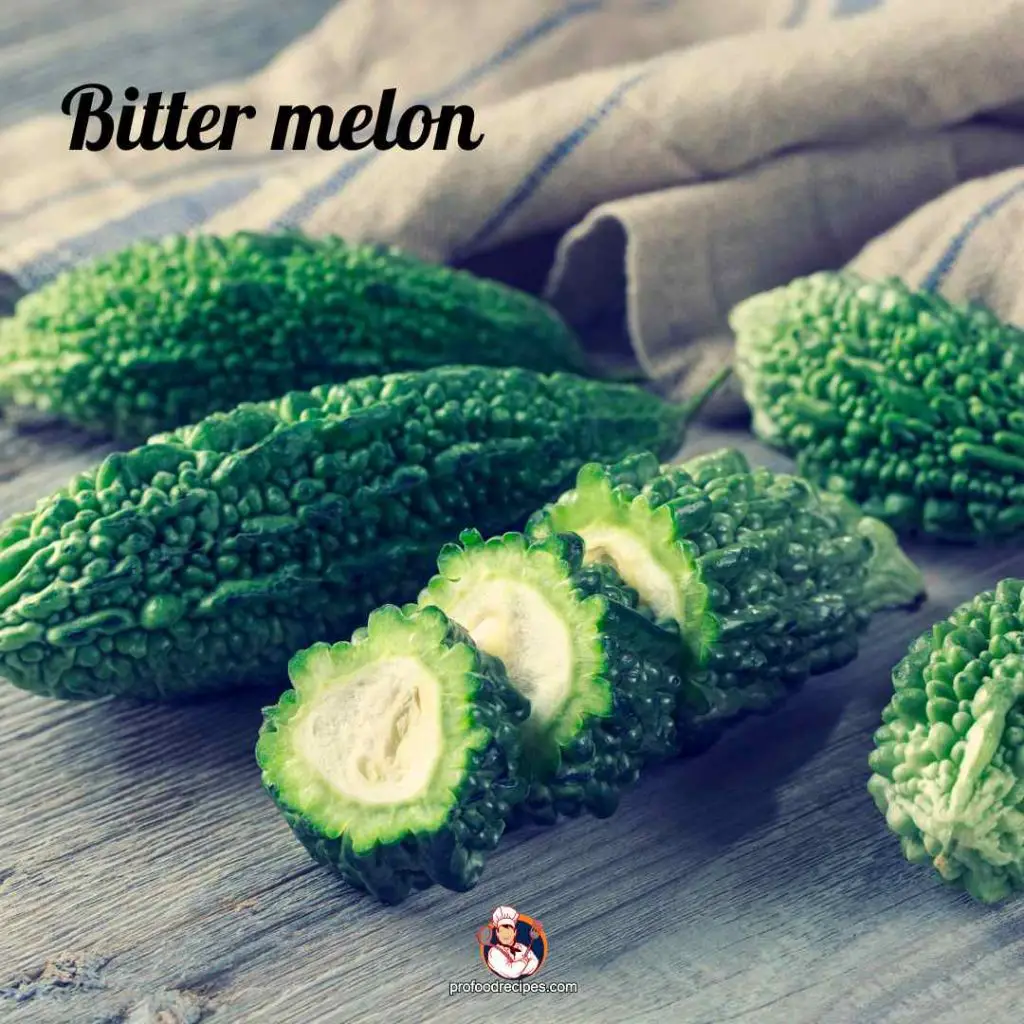
Bitter melon, also called bitter gourd, derived its name from its intensely bitter taste, which intensifies as it ripens. Resembling a bumpy, green cucumber, it’s globally cultivated and a culinary favorite in Asia.
Packed with potent antioxidants like epicatechin, catechin, gallic acid, and chlorogenic acid. It defends against oxidative damage, heart diseases, shielding against cancer, aging, and chronic ailments. Enjoyed cooked in various dishes like curries, stir-fries, and deep-fried. It’s also stuffed with meats for diverse flavors.
| Nutrition | Quantity |
| Calories | 17 kcal |
| Carbohydrates | 3.7 g |
| Dietary Fiber | 2.6 g |
| Sugars | 1 g |
| Fat | 0.2 g |
| Protein | 1 g |
| Calcium | 19 mg |
| Iron | 0.43 mg |
| Vitamin C | 84 mg (140% of the Daily Value) |
| Vitamin A | 471 IU (9% of the Daily Value) |
| Potassium | 319 mg |
| Folate | 72 µg (18% of the Daily Value) |
10. Bael Fruit
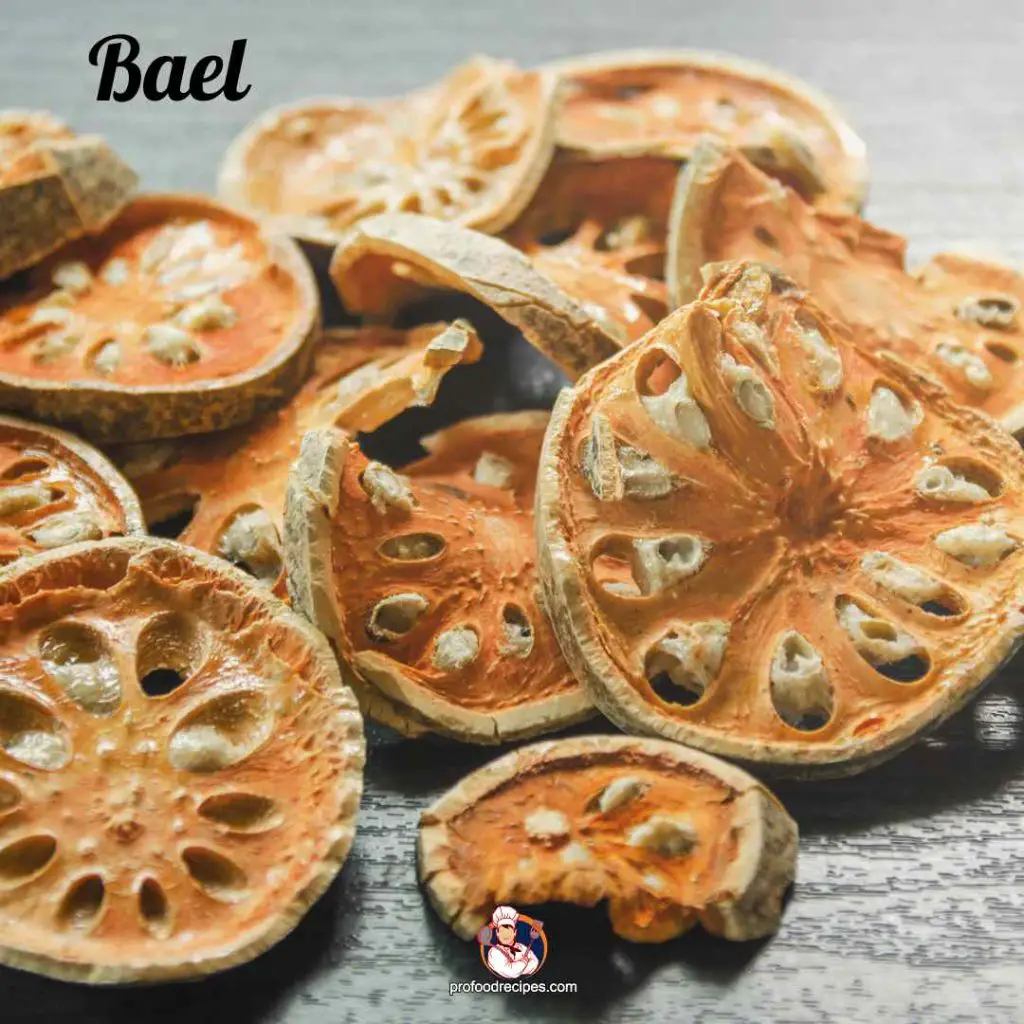
The tropical bael fruit, also known as Bengal quince or golden apple, is native to India and Bangladesh and cherished in Hindu culture. Its scientific name is Aegle marmelos.
This sacred fruit boasts a taste reminiscent of papaya and tangy citrus. It is renowned for its Ayurvedic medicinal effects and can be consumed fresh, dried, or juiced. Due to its strong digestive properties, moderation is essential.
Read More:
| Nutrition | Quantity |
| Calories | 137 kcal |
| Carbohydrates | 31.8 g |
| Dietary Fiber | 2.6 g |
| Sugars | 25.7 g |
| Fat | 0.3 g |
| Protein | 1.8 g |
| Calcium | 85 mg |
| Iron | 1.8 mg |
11. Ballon Berry
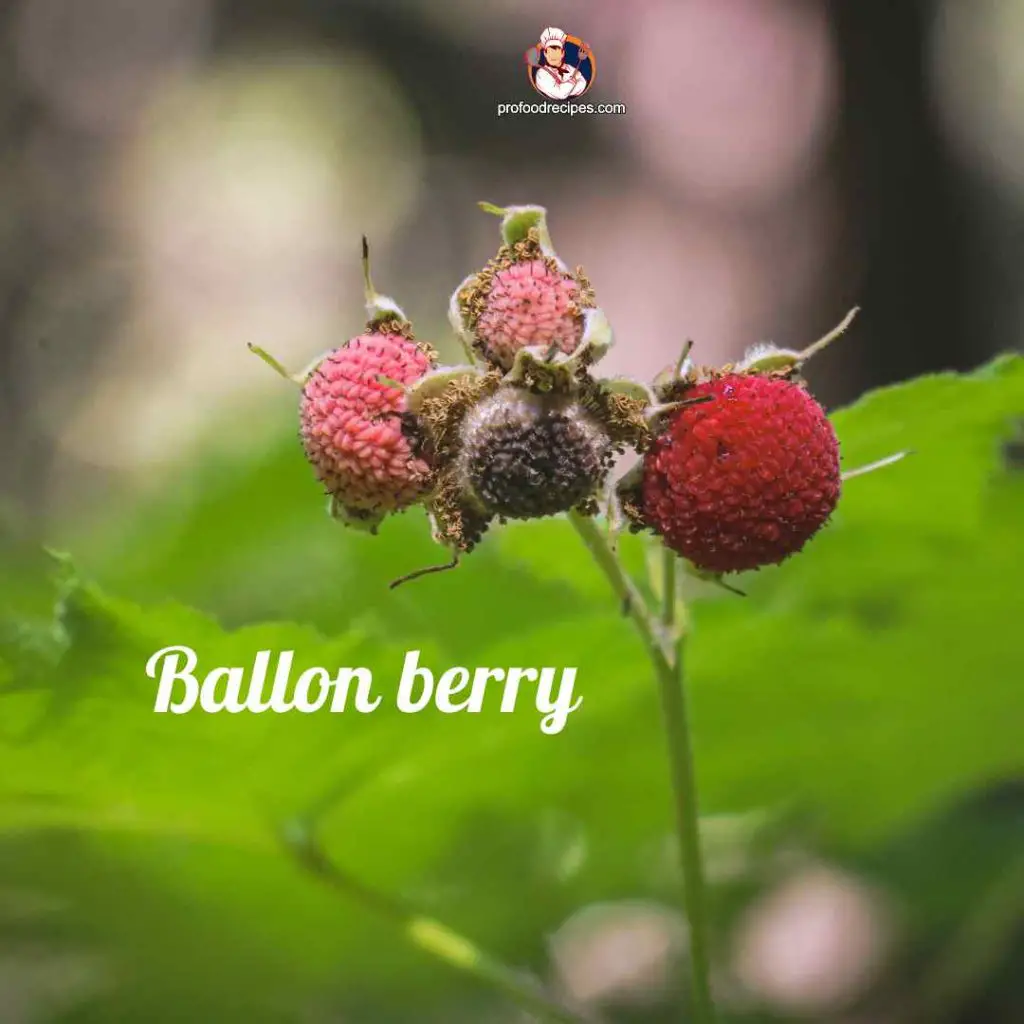
Originating in Japan, the balloon berry, often called “strawberry raspberry,” boasts a unique blend of strawberry and raspberry appearance. Popular in Lithuania, it’s scientifically known as Rubus illecebrosus.
With a subtly sweet and tart flavor, it’s a source of antioxidants and vitamins, providing health benefits. Its versatility in jams, desserts, and beverages, enhances culinary encounters with its vibrant color and unique taste.
| Nutrition | Quantity |
| Energy | 64 cal |
| Protein | 1.5 g |
| Carbohydrate | 14.7 g |
| Sugar | 5.4 g |
| Fiber | 8.0 g |
12. Balsam Apple
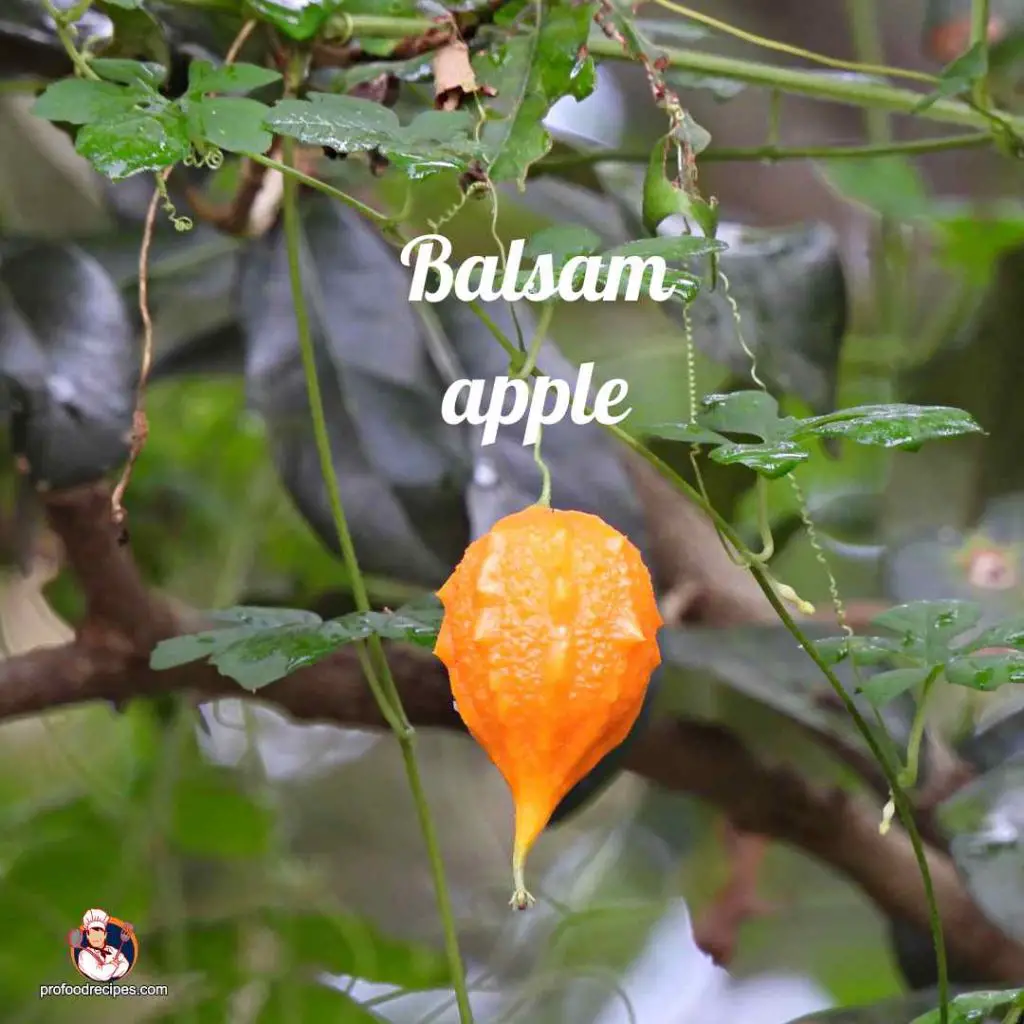
Native to Africa, the Balsam apple (Momordica balsamina) historically treated wounds in Europe in the 1500s. This tropical vine yields bright orange fruits, transforming from green and warty to bursting vibrant yellow, revealing red seeds. Its taste becomes bitter when ripe.
Leaves and young fruits are consumed as vegetables in parts of Africa. Therefore, it is also used for wound healing, vaginal discharge, colic, menstrual issues, and even induces abortion.
Note: When this fruit is ripe, it becomes poisonous; avoid consumption for safety.
| Nutrition | Quantity |
| Calories | 17 kcal |
| Carbohydrates | 3.7 g |
| Dietary Fiber | 2.6 g |
| Sugars | 1 g |
| Fat | 0.2 g |
| Protein | 1 g |
| Calcium | 19 mg |
| Iron | 0.43 g |
13. Banganapalle Mango
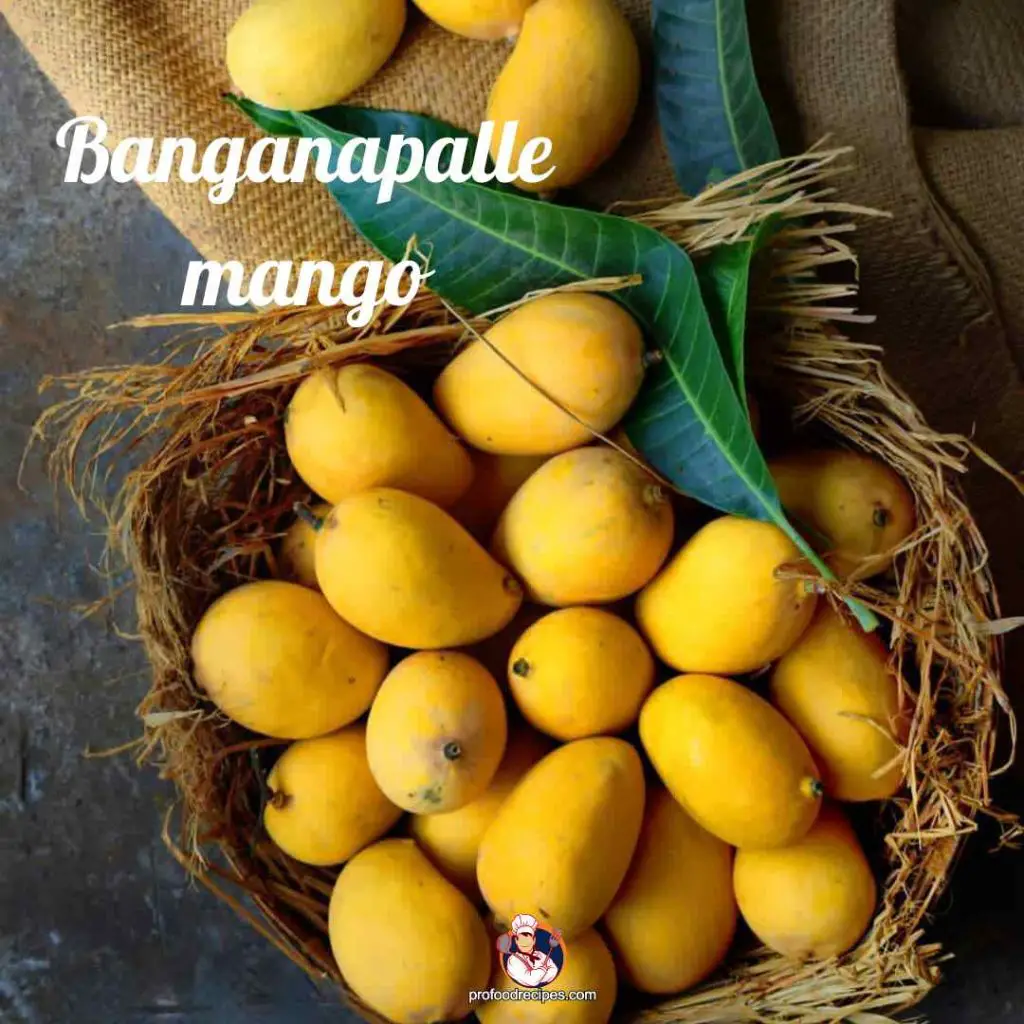
Mangoes of the Banganapalle kind are grown in a specific region of India. Large and oblong, it has sweet yellow flesh with a hint of citrus.
It is high in vitamins A and C, promoting immune health and skin vitality. Enjoyed fresh, as juice, or in dishes, it’s a delightful and nutritious tropical treat.
| Nutrition | Quantity |
| Calories | 60 kcal |
| Carbohydrates | 15 g |
| Dietary Fiber | 1.8 g |
| Sugars | 13.2 g |
| Fat | 0.4 g |
| Protein | 0.5 g |
| Calcium | 11 mg |
| Iron | 0.16 mg |
| Potassium | 168 mg |
14. Baobab Fruit
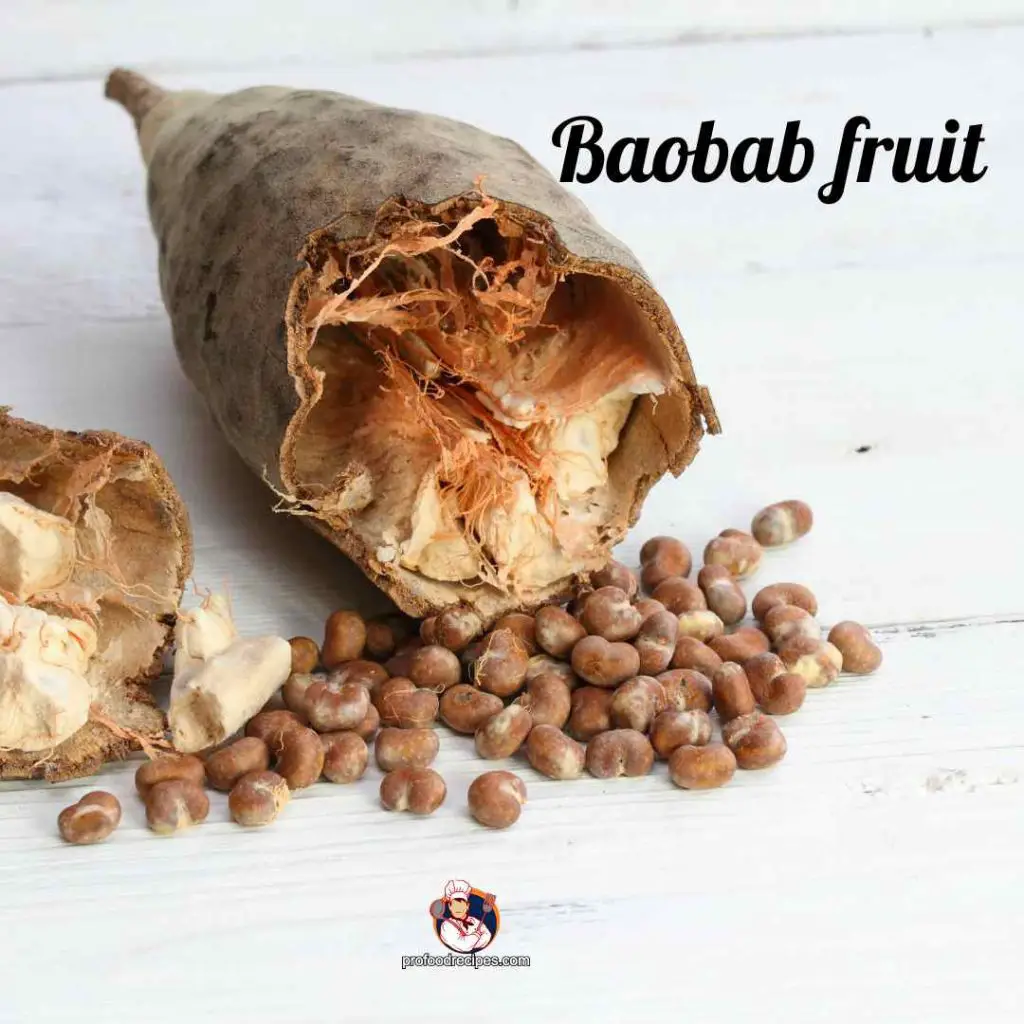
The tropical fruit baobab grows in Australia, the Middle East, and parts of Africa. Its ripe white flesh bears a yogurt-like taste with gentle sweetness. Encased in hanging pods, seeds are ground into chalky powder.
Loaded with vitamin C, minerals, and antioxidants, it aids in reducing inflammation, boosting immunity, stabilizing blood sugar, and keeping skin healthy. However, used in edibles and drinks, its nutritional potency enriches diets.
| Nutrition | Quantity |
| Calories | 240 kcal |
| Carbohydrates | 74 g |
| Dietary Fiber | 44 g |
| Sugars | 25 g |
| Fat | 0.4 g |
| Protein | 2 g |
| Calcium | 330 mg (33% Daily Value) |
| Iron | 2.7 mg (15% Daily Value) |
| Magnesium | 290 mg (73% of the Daily Value) |
| Potassium | 1600 mg (34% of the Daily Value) |
| Vitamin C | 130 mg (217% of the Daily Value) |
15. Barbados Cherry
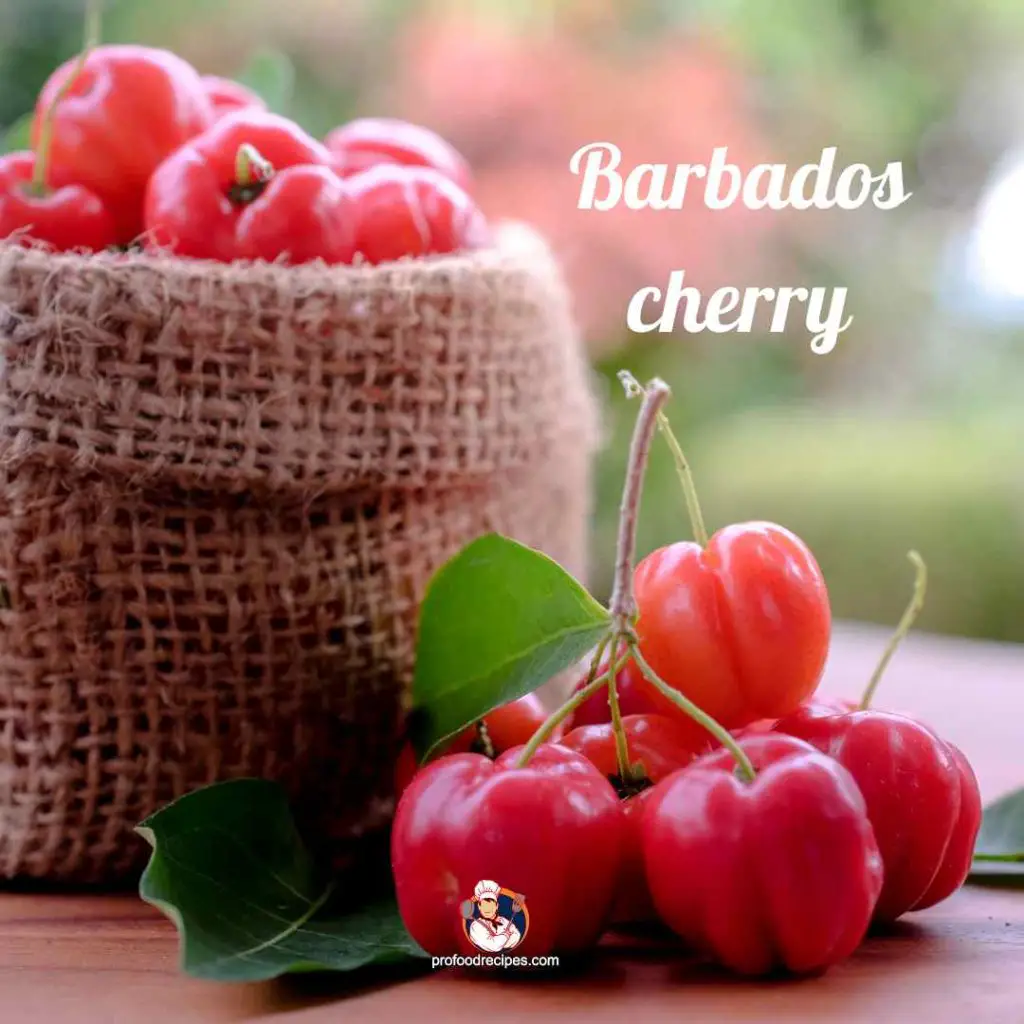
Barbados cherries, resembling miniature red apples, boast a sweet-tart taste. Also known as “acerola cherries,” they’re a Caribbean and South American favorite. Enjoy them fresh or in juices and jams. Abundant in vitamin C, they boost immunity and collagen production while combating oxidative stress.
| Nutrition | Quantity |
| Calories | 32 kcal |
| Carbohydrates | 7.7 g |
| Dietary Fiber | 1.1 g |
| Sugars | 4.5 g |
| Fat | 0.2 g |
| Protein | 0.4 g |
| Calcium | 12 mg |
| Iron | 0.2 mg |
16. Bayberry
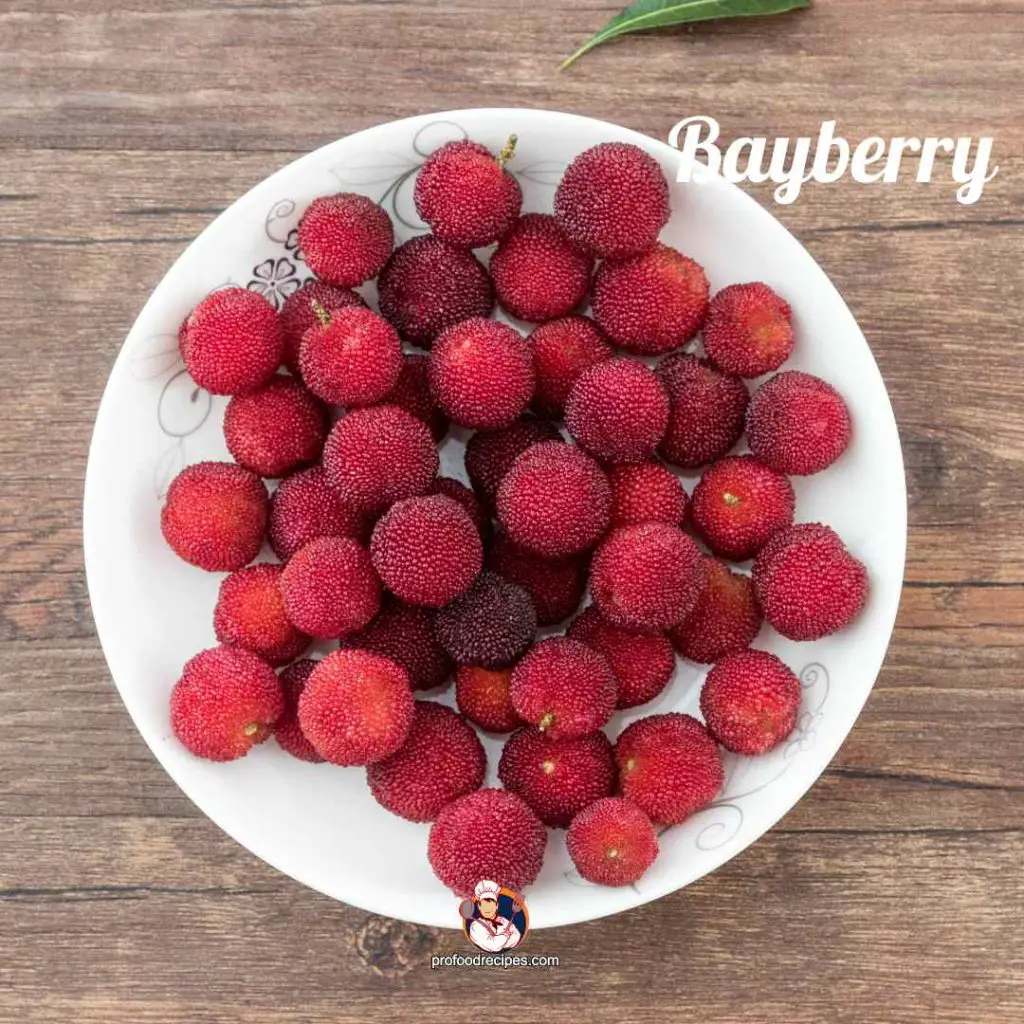
Bayberries, ranging from white to red and deep purple, present a delectable balance of sweetness and tartness. Known as yumberries or tree strawberries, their juicy pulp can leave a striking stain on lips.
Beyond fresh enjoyment and juicing, they’re preserved through canning, drying, or pickling. Additionally, bayberry offers circulatory stimulation, infection-fighting prowess, relief for colds and flu, and soothing effects on mucous membranes.
| Nutrition | Quantity |
| Calories | 89 kcal |
| Carbohydrates | 24 g |
| Dietary Fiber | 16.7 g |
| Sugars | 6.9 g |
| Fat | 0.3 g |
| Protein | 1.3 g |
| Calcium | 40 mg |
| Iron | 1.9 mg |
| Potassium | 253 mg |
17. Beach Plum
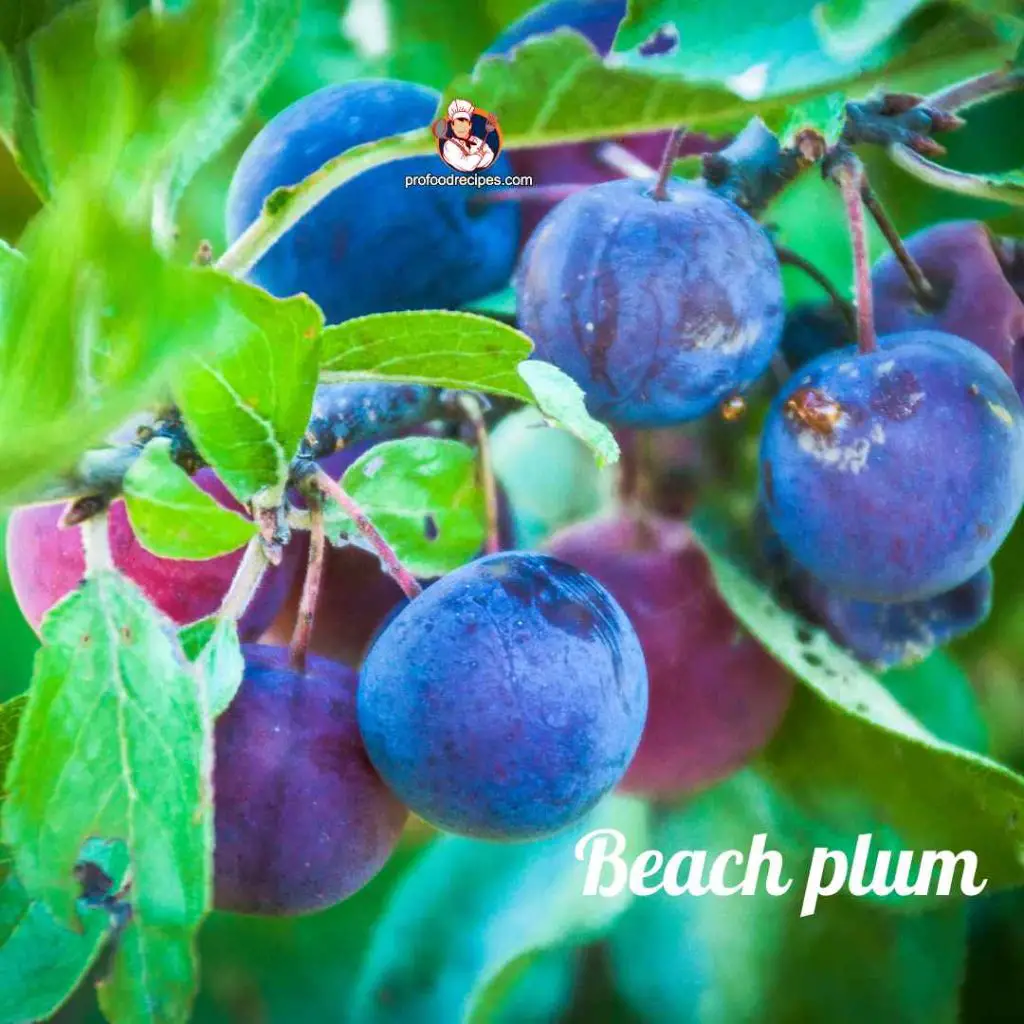
Beach plums, petite and dark purple, have a distinct combination of sweetness and acidity. Native to North America’s coastlines, they’re prized for jams, jellies, and baked treats. Packed with antioxidants and fiber, they support digestive health and immunity. Their distinct flavor and versatile use make beach plums a coastal delight.
| Nutrition | Quantity |
| Calories | 50 kcal |
| Carbohydrates | 14 g |
| Dietary Fiber | 2.3 g |
| Sugars | 7.4 g |
| Fat | 0.2 g |
| Protein | 0.5 g |
| Calcium | 11 mg |
18. Betel Nut
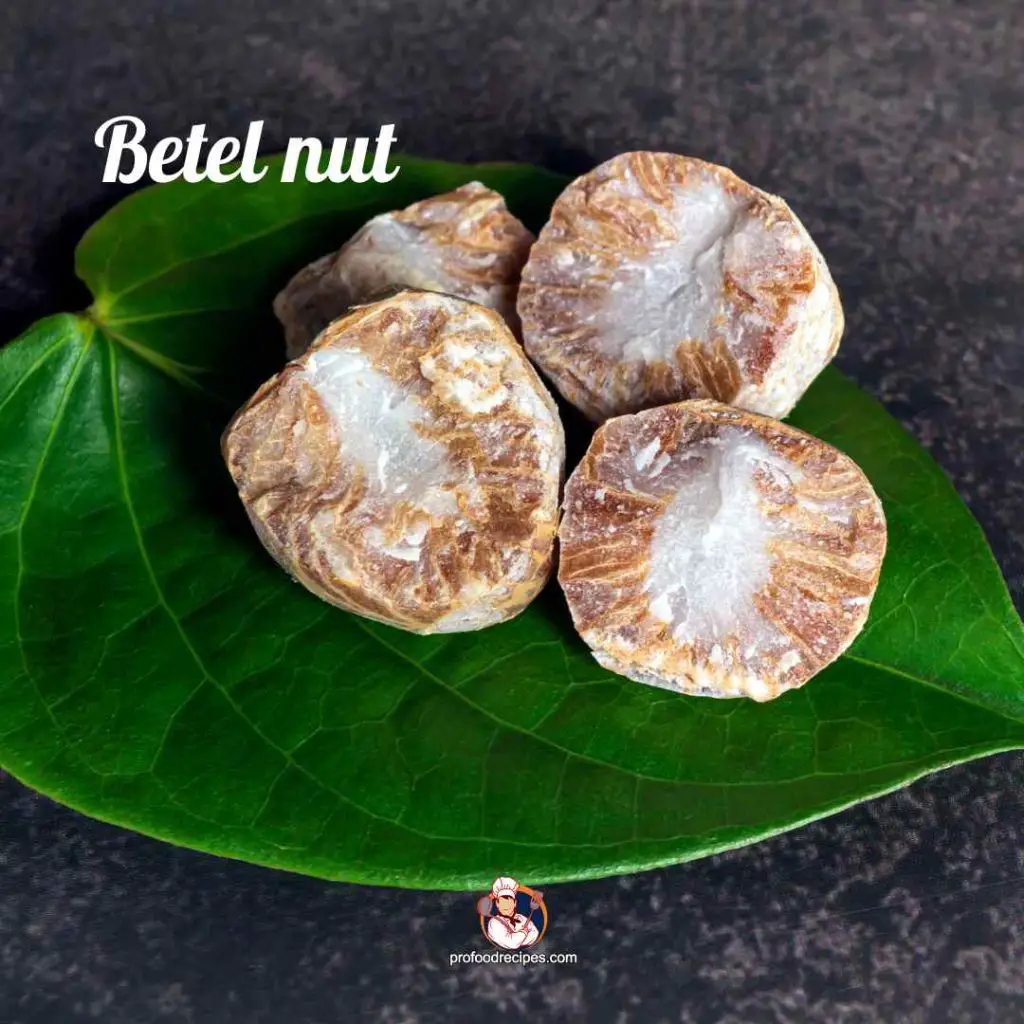
Betel nut, also known as areca nut, offers a slightly bitter taste and is typically wrapped in betel leaves. Originating in Asia, it’s traditionally used in cultural practices and rituals, often chewed for stimulating effects.
However, its consumption poses health risks, including oral health issues and links to certain cancers. Additionally, it can also weaken your teeth and leave permanent black stains.
| Nutrition | Quantity |
| Calories | 190 kcal |
| Carbohydrates | 13.1 g |
| Dietary Fiber | 6.7 g |
| Sugars | 0.6 g |
| Fat | 14.8 g |
| Protein | 2.2 g |
| Calcium | 85 mg |
19. Bilberry
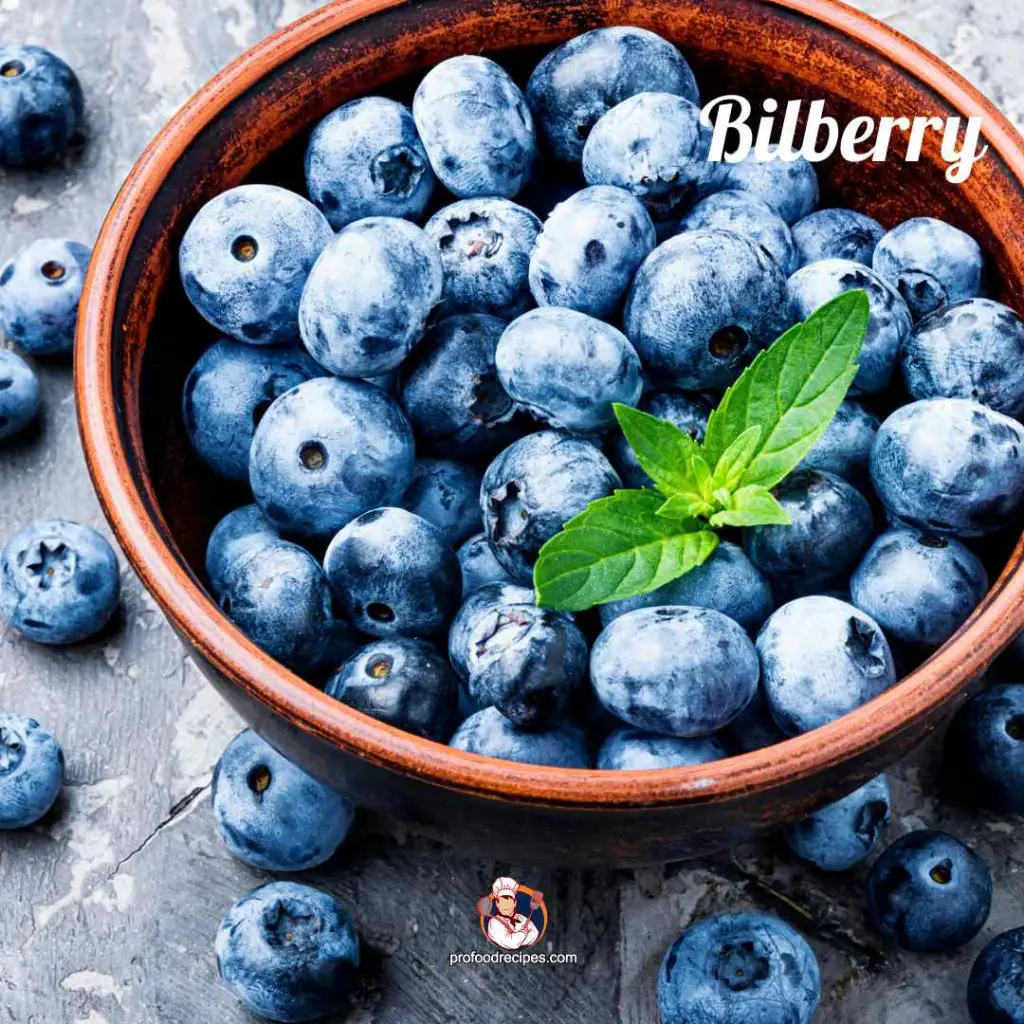
Bilberries, also called wimberries and whortleberries, thrive across the northern hemisphere. Dark blue to black-purple when ripe, they’re enjoyed fresh or used in jams, jellies, tarts, muffins, and liquors. Additionally, due to its staining characteristics, Britain dyes food and garments using it. Slightly larger and more acidic than blueberries, they offer a sweet-tart taste.
Moreover, rich in antioxidants, it promotes eye health, combat inflammation, and enhance circulation, potentially benefiting heart and brain function.
| Nutrition | Quantity |
| Calories | 32 kcal |
| Carbohydrates | 7.7 g |
| Dietary Fiber | 2.4 g |
| Sugars | 4.1 g |
| Fat | 0.6 g |
| Protein | 0.7 g |
| Calcium | 6 mg |
| Iron | 0.4 mg |
20. Bilimbi
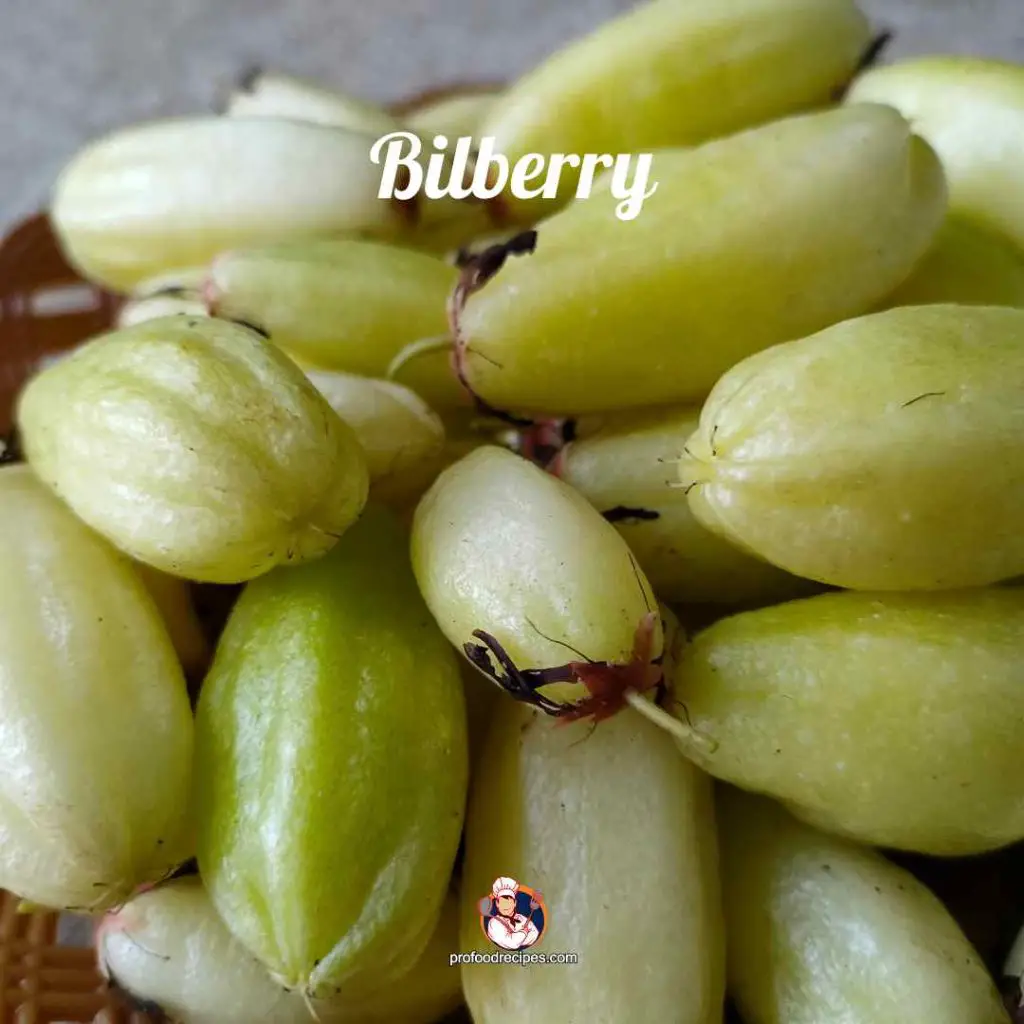
Originating in Malaysia and Indonesia, the elongated green bilimbi fruit boasts a refreshing cucumber-like taste with a distinct sourness. Abundant in oxalic acid, it offers robust tartness, often utilized through pickling for savory dishes. Beyond pickling, it finds versatility in raw consumption, cooking, and inclusion in juices and jams.
Moreover, a staple in Indonesian cuisine, it exhibits antidiabetic, antihypertensive, and anticancer effects with potent antioxidative, anti-inflammatory, and antimicrobial properties.
| Nutrition | Quantity |
| Calories | 13 kcal |
| Carbohydrates | 3.5 g |
| Dietary Fiber | 1.4 g |
| Sugars | 0.7 g |
| Fat | 0.6 g |
| Protein | 0.6 g |
| Calcium | 9 mg |
| Iron | 0.7mg |
21. Black Mulberry
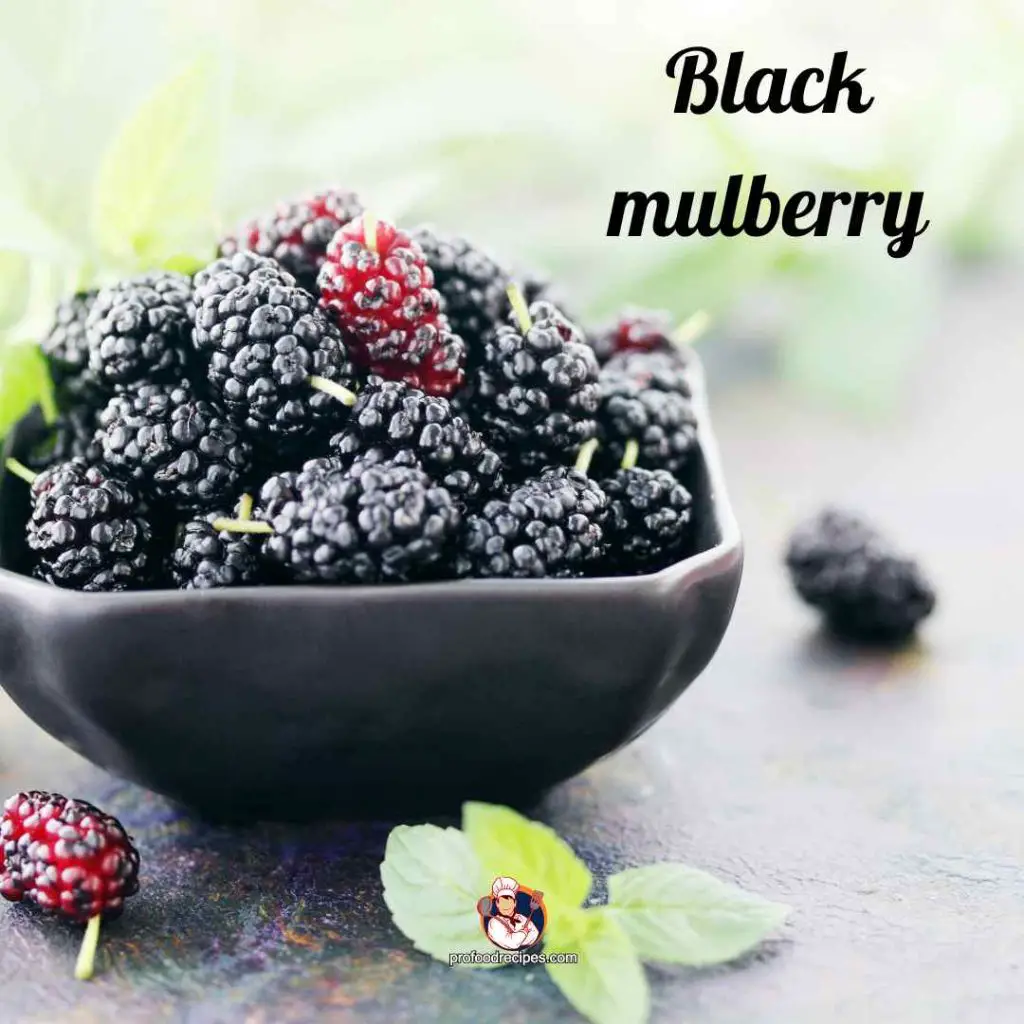
Resembling elongated blackberries, black mulberries are both juicy and sweet, making them a desirable substitute for blackberries. They’re commonly incorporated into jams and jellies.
The chemicals found in both the fruit and twigs are believed to have potential blood sugar-reducing effects. Additionally, black mulberries find versatile applications among people.
| Nutrition | Quantity |
| Calories | 43 kcal |
| Carbohydrates | 9.8 g |
| Dietary Fiber | 1.7 g |
| Sugars | 8.1 g |
| Fat | 0.4 g |
| Protein | 1.4 g |
| Calcium | 39 mg |
22. Black Sapote
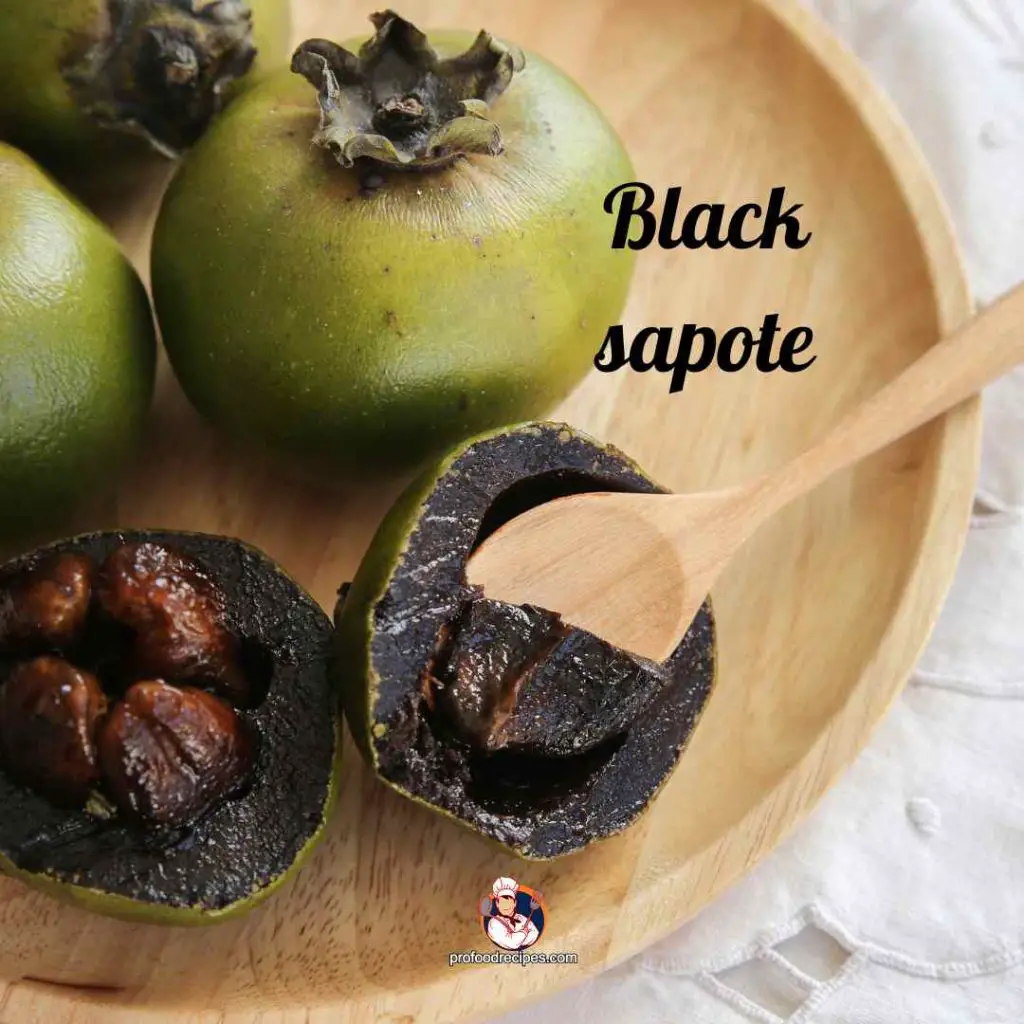
Fruits that begin with “b” category, the black sapote originates in Mexico, resembling the persimmon. Its pudding-like interior offers a subtly sweet, nutty pumpkin flavor. With roughly 350mg of potassium, it aids muscle growth, fluid balance, and heart health. Mashed black sapote adds nutritional value to brownies, baked goods, and smoothies.
| Nutrition | Quantity |
| Calories | 132 kcal |
| Carbohydrates | 28.3 g |
| Dietary Fiber | 10.2 g |
| Sugars | 22.6 g |
| Fat | 0.9 g |
| Protein | 1.7 g |
| Calcium | 39 mg |
| Iron | 0.9 mg |
23. Blackcurrants
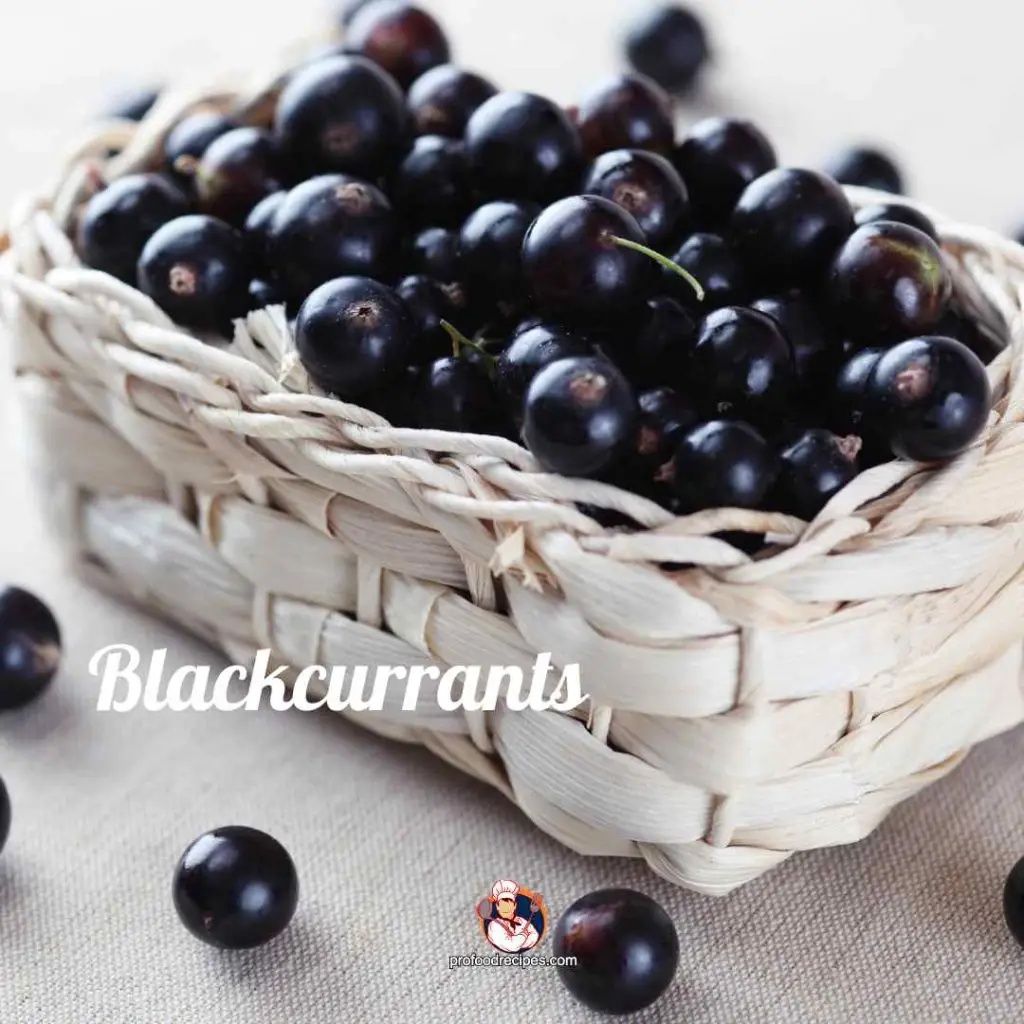
Black currants, packed with antioxidants and Vitamin C, stand as a potent fruit. Different from blueberries, they boast a distinct tangy, earthy flavor. Their homeopathic uses aid blood flow, immunity, and organ health.
Their juiciness enhances culinary creations like jams, tarts, and juices. Also, leaves make nutritious teas; fruit act as colorants for foods, fabrics, and makeup.
| Nutrition | Quantity |
| Calories | 63 kcal |
| Carbohydrates | 15.4 g |
| Dietary Fiber | 5.3 g |
| Sugars | 7.4 g |
| Fat | 0.4 g |
| Protein | 1.4 g |
| Calcium | 55 mg |
24. Bolwarra

Bolwarra, native to Australia, thrives in New South Wales rainforests. Among fruit with b, its green exterior conceals guava-like insides that turn yellow when ripe. Valued for cooking and jams, it’s a fiber-rich choice aiding digestion, cholesterol reduction, and blood sugar regulation. Its flavor is a tantalizing mix of sweet and sour.
| Nutrition | Quantity |
| Carbohydrates | 23.38g |
| Protein | 2.20g |
| Total fat | 0.70g |
| Cholesterol | 0mg |
| Dietary fiber | 10.40g |
| Energy | 97kcal |
25. Brazilian Guava Fruit
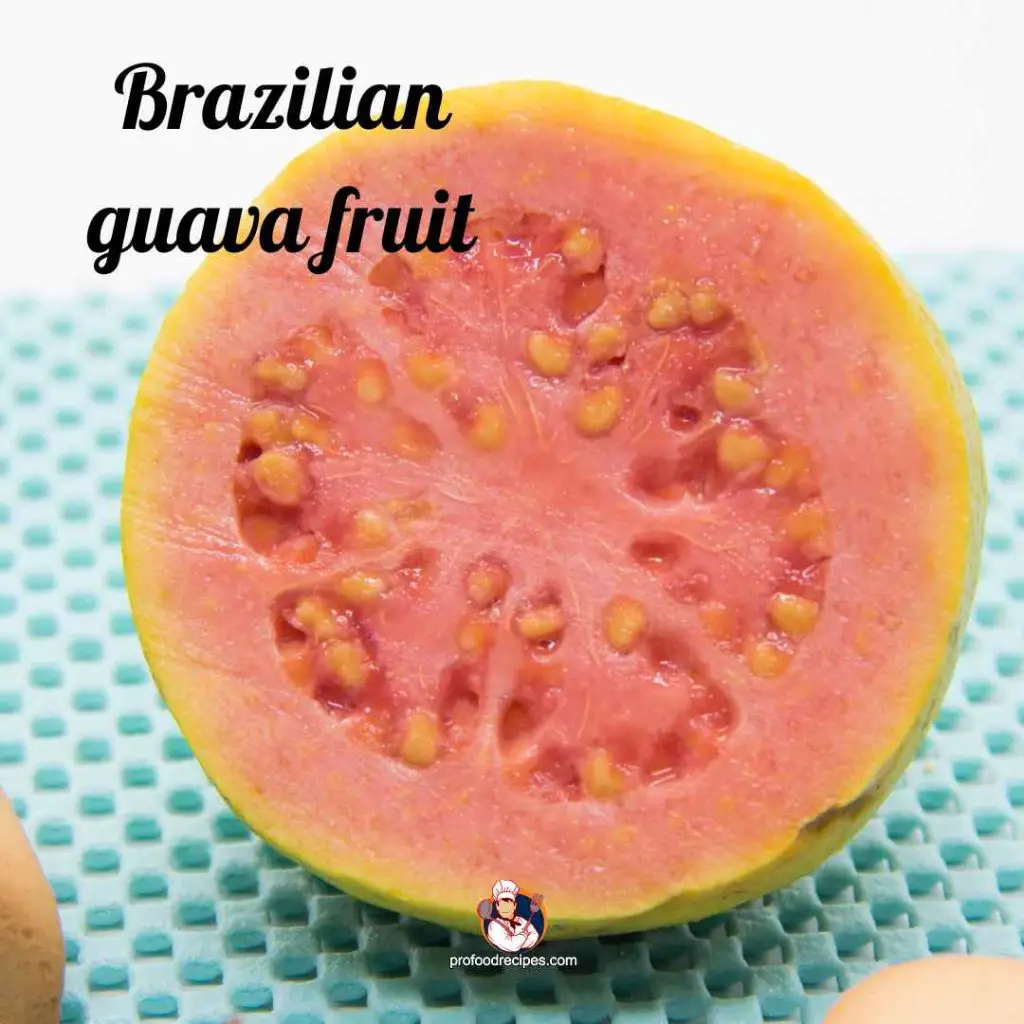
Originating in its namesake country, Brazilian Guava is a tropical fruit also found in Peru and Mexico. It has a dense, pear-like exterior and sweet, strawberry-flavored flesh.
In Brazil, it’s dried into gummy desserts and used in pies, sandwiches, sorbets, juices, and jams. However, their rich sources of vitamin C, lycopene, and low-calorie aids in diabetes, heart health, digestion, immunity, and weight loss.
| Nutrition | Quantity |
| Calories | 68 kcal |
| Carbohydrates | 14.32 g |
| Dietary Fiber | 5.4 g |
| Sugars | 8.92 g |
| Fat | 1.02 g |
| Protein | 2.6 g |
| Calcium | 18 mg |
| Iron | 0.26 mg |
26. Burmese Grapes
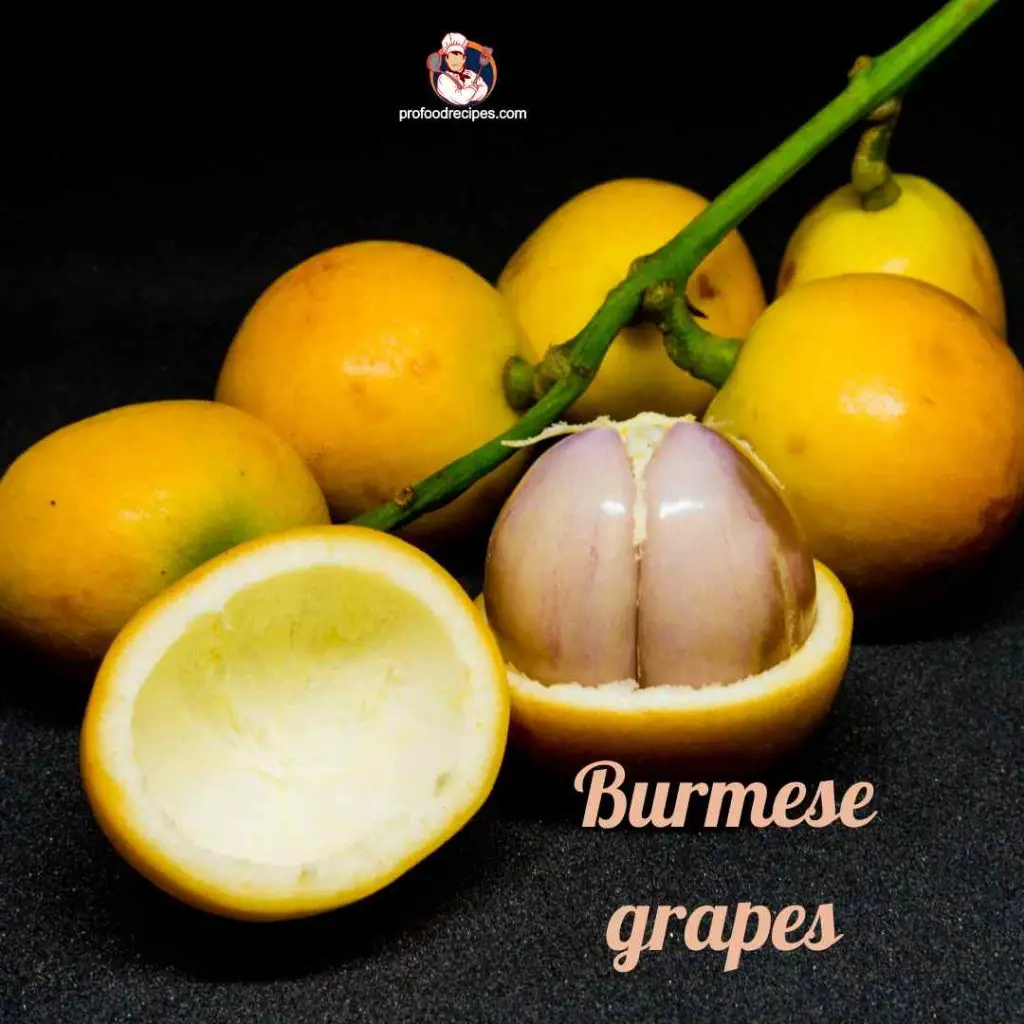
Burmese grapes, a rare Asian find, showcase an oval shape, yellow-pink skin, and fibrous white pulp. They offer a fibrous texture, sweet-sour flavor similar to lychee, though less juicy. Rich in vitamins, minerals, and pectin, they’re transformed into jams, jellies. Beyond fruit, their bark, roots, and wood serve medicinal purposes.
| Nutrition | Quantity |
| Calories | 32 kcal |
| Carbohydrates | 7.1 g |
| Dietary Fiber | 1.6 g |
| Sugars | 3.9 g |
| Fat | 0.3 g |
| Protein | 0.6 g |
| Calcium | 22 mg |
| Iron | 0.5 mg |
27. Breadfruit
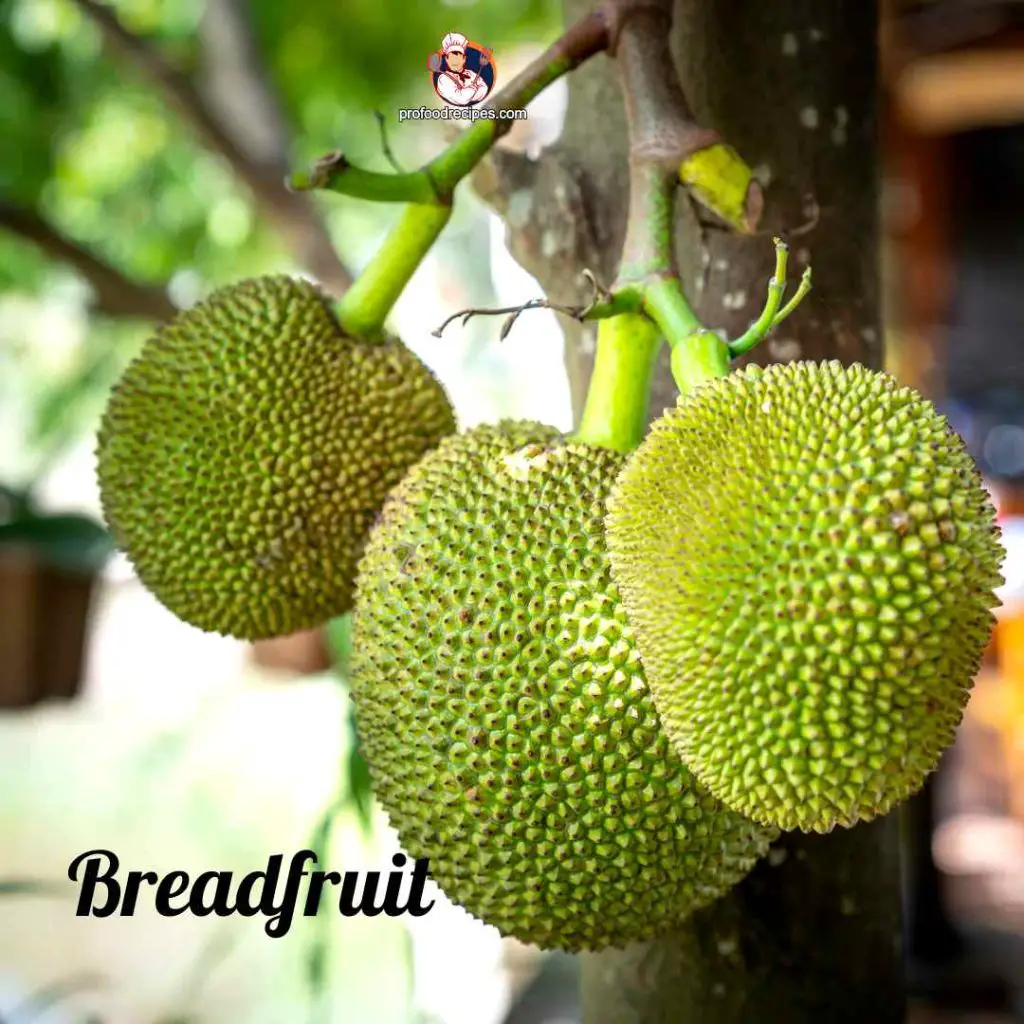
Breadfruit varieties starting b are grown in Peru and Puerto Rico. Despite its unappealing appearance, it offers a savory bread-like flavor. Used akin to potatoes, it’s versatile—mashed, baked, sautéed, or fried. It boosts immunity, skin, hair, and bones while being rich in fiber, proteins, vitamins, and minerals.
| Nutrition | Quantity |
| Calories | 102 kcal |
| Carbohydrates | 27.1 g |
| Dietary Fiber | 4.9 g |
| Sugars | 11.8 g |
| Fat | 0.2 g |
| Protein | 1 g |
| Calcium | 17 mg |
28. Bolivian Mountain Coconut
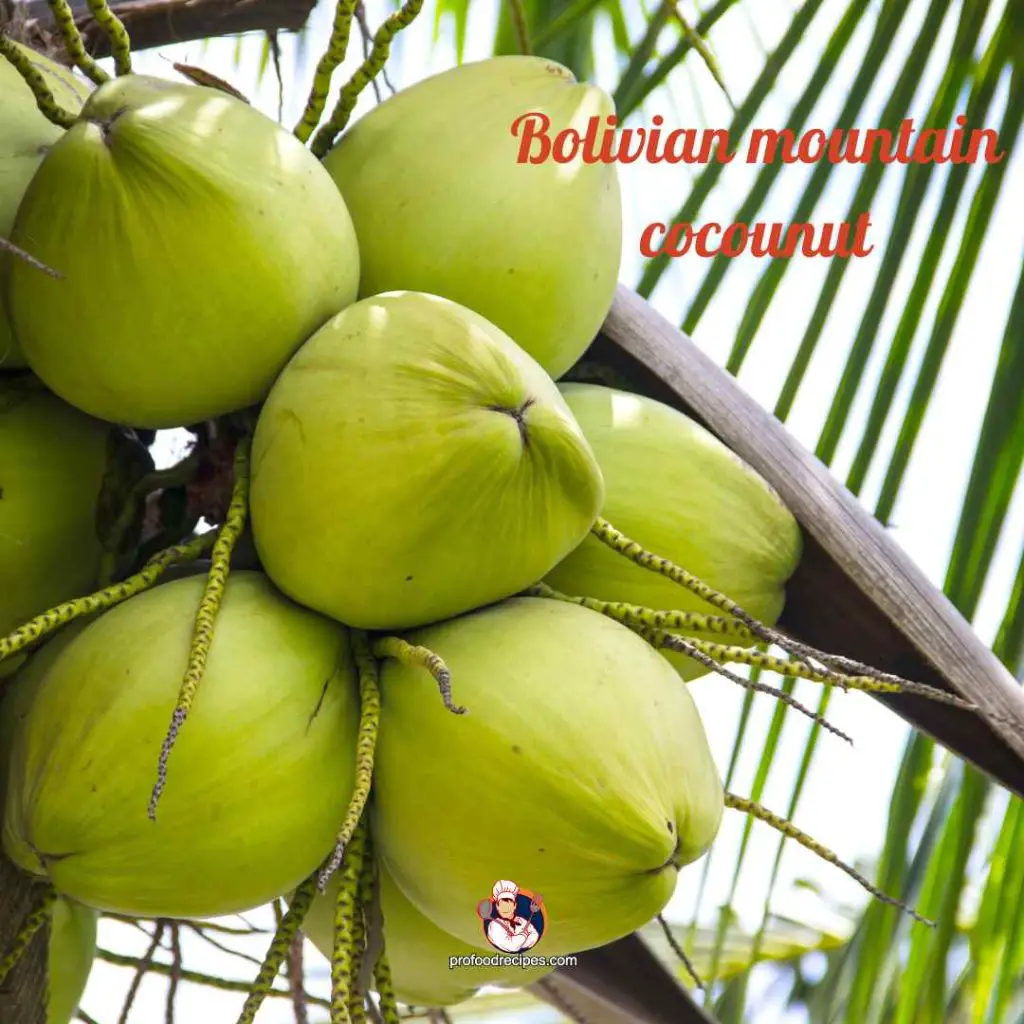
Mountain coconuts, Parajubaea cocoides, arise from South American Arecaceae palms. They’re valued as edible snacks when they are developing in cascading clusters atop 16 to 20-meter-tall palms.
With a mild, rich, subtly sweet flavor, their fleshy endosperms require removal from sturdy shells, promoting digestion and showcasing Bolivia’s tropical essence.
| Nutrition | Quantity |
| Calories | 354 |
| Cholesterol | 0mg |
| Sodium | 20mg |
| Total fat | 33.49g |
| Total carbohydrates | 15.23g |
| Protein | 3.33g |
29. Bignay
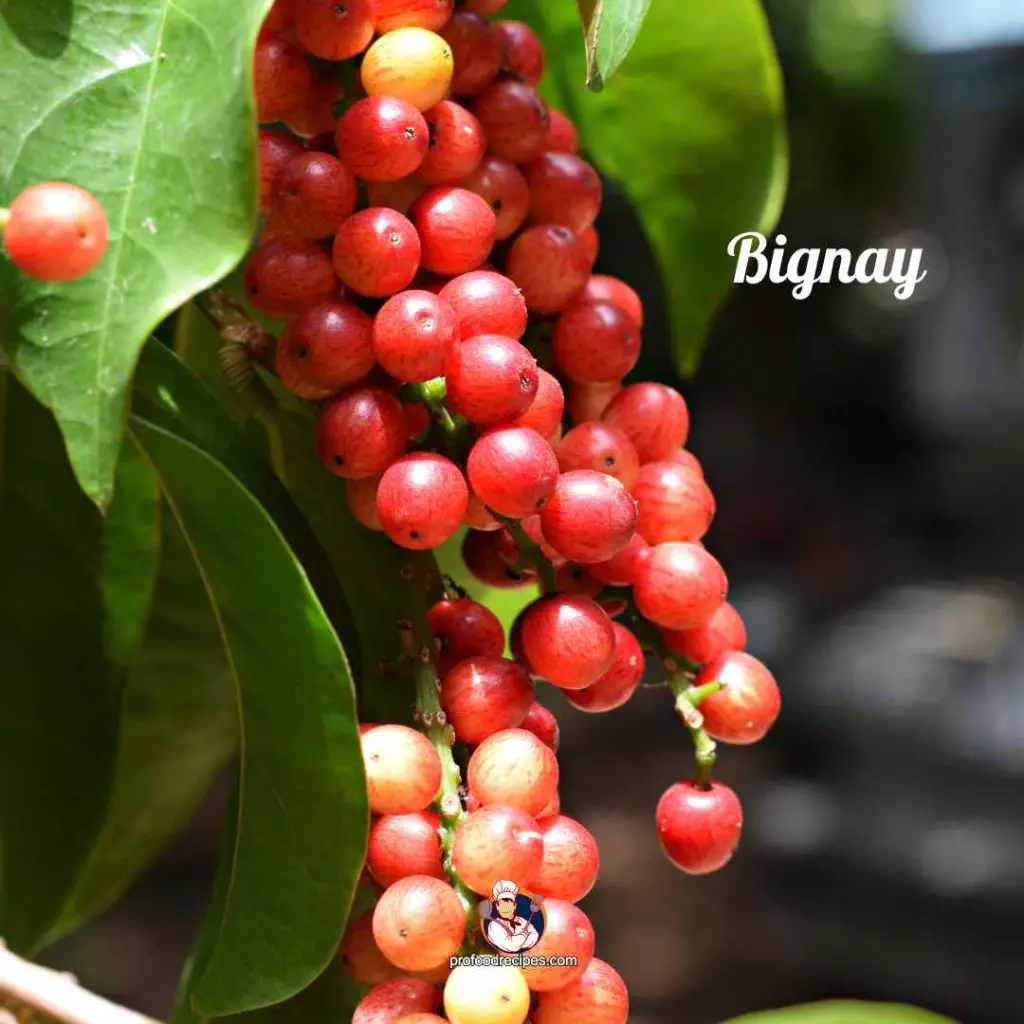
Bignay, similar to grapes, clusters as small, whitish-green sour fruits maturing into sweet, red, or purple ones. Native to Southeast Asia and Northern Australia, they’re enjoyed fresh or used for jams, jellies, and teas. Their polyphenols manage cholesterol, while thermal processing impacts lipase inhibition, suggesting dyslipidemia potential.
| Nutrition | Quantity |
| Calories | 49 kcal |
| Carbohydrates | 12.6 g |
| Dietary Fiber | 1.9 g |
| Sugars | 3.2 g |
| Fat | 0.3 g |
| Protein | 1 g |
| Calcium | 11 mg |
| Iron | 0.6 mg |
| Vitamin C | 32 mg (53% of the Daily Value) |
30. Bush Butter Fruit
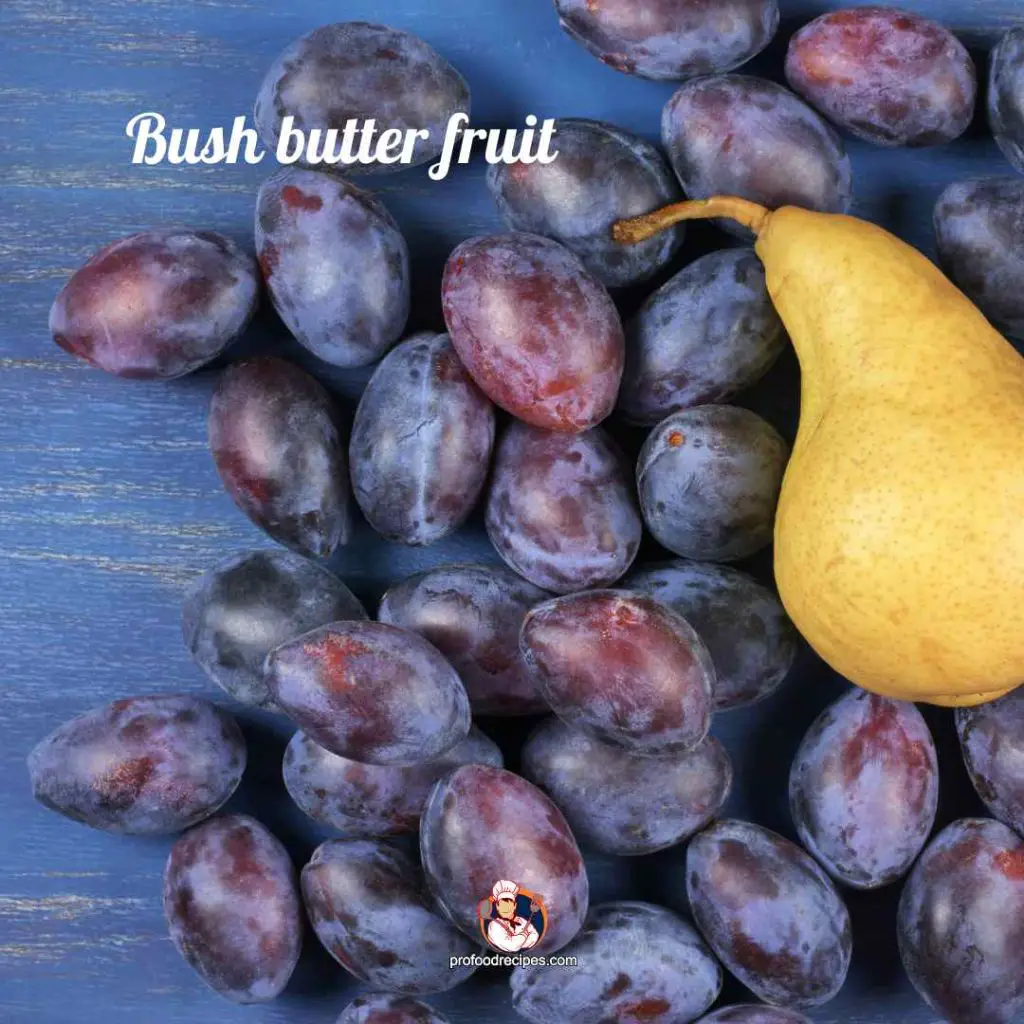
This fruit, also known as safou or butter fruit, has a buttery texture when cooked and is commonly smeared on toast. It tastes like warm, ripe avocado with a hint of sourness.
Its pulpy pericarp is rich in minerals and oil, which are beneficial for the skin. It’s classified among fruits starting with b, known scientifically as Dacryodes edulis.
| Nutrition | Quantity |
| Energy | 612.47 kcal – 648.10 kcal |
| Proteins | 13.54 g – 14.34 g |
| Carbohydrates | 8.93 g – 13.97 g |
| Ash | 2.55 g – 3.62 g |
| Dietary fibre | 8.43 g – 22.04 g |
| Moisture | 10.63 % – 11.99 % |
31. Broadleaf Bramble Fruit
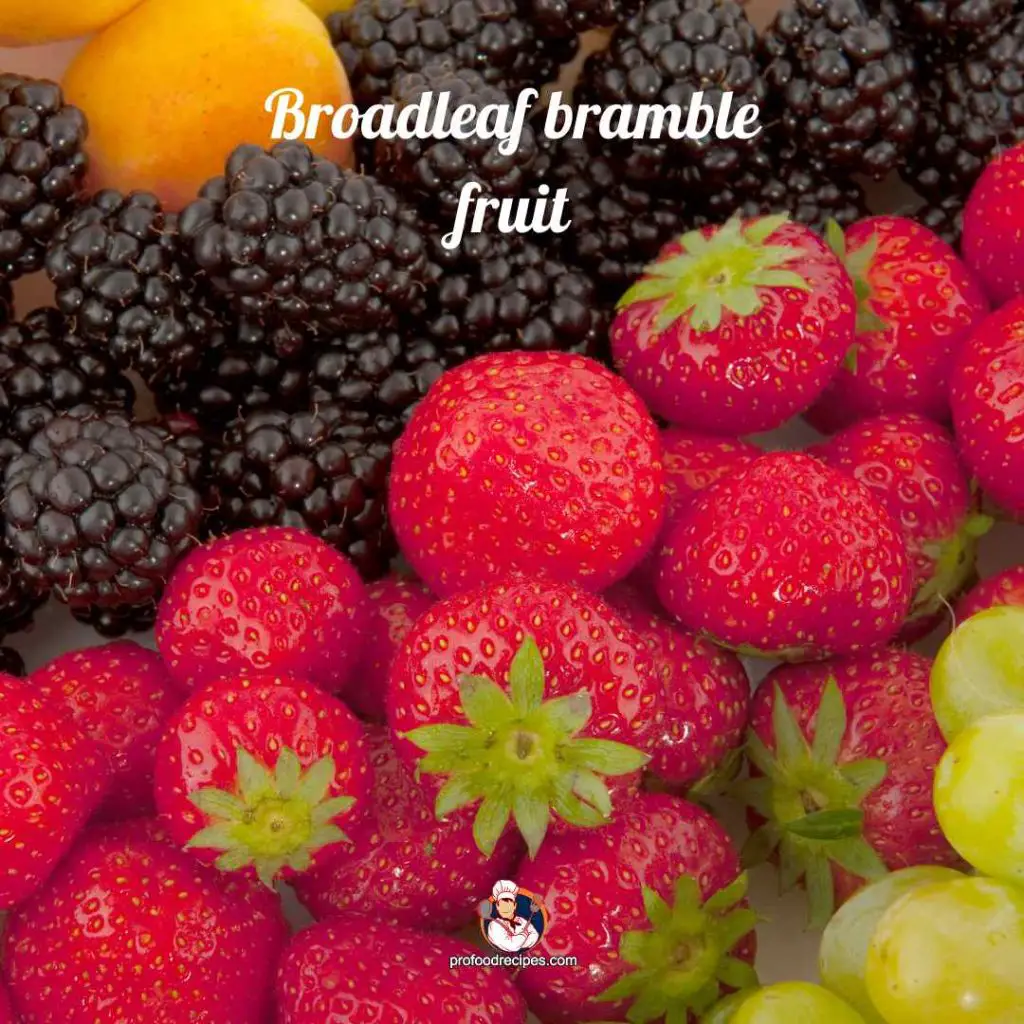
The Broadleaf Bramble (AKA Molucca bramble), native to Australia, produces edible berries perfect for eating fresh, making jams, and baking. Alongside other fruits that start with the letter B, such as bananas and blackberries, these tangy berries are rich in Vitamin C, iron, and magnesium, offering antioxidants for defense against certain diseases.
| Nutrition | Quantity |
| Energy | 43Kcal |
| Carbohydrates | 9.61 g |
| Protein | 1.39 g |
| Total Fat | 0.49 g |
| Cholesterol | 0 mg |
| Dietary Fiber | 5.3 g |
32. Blue Tongue Fruit
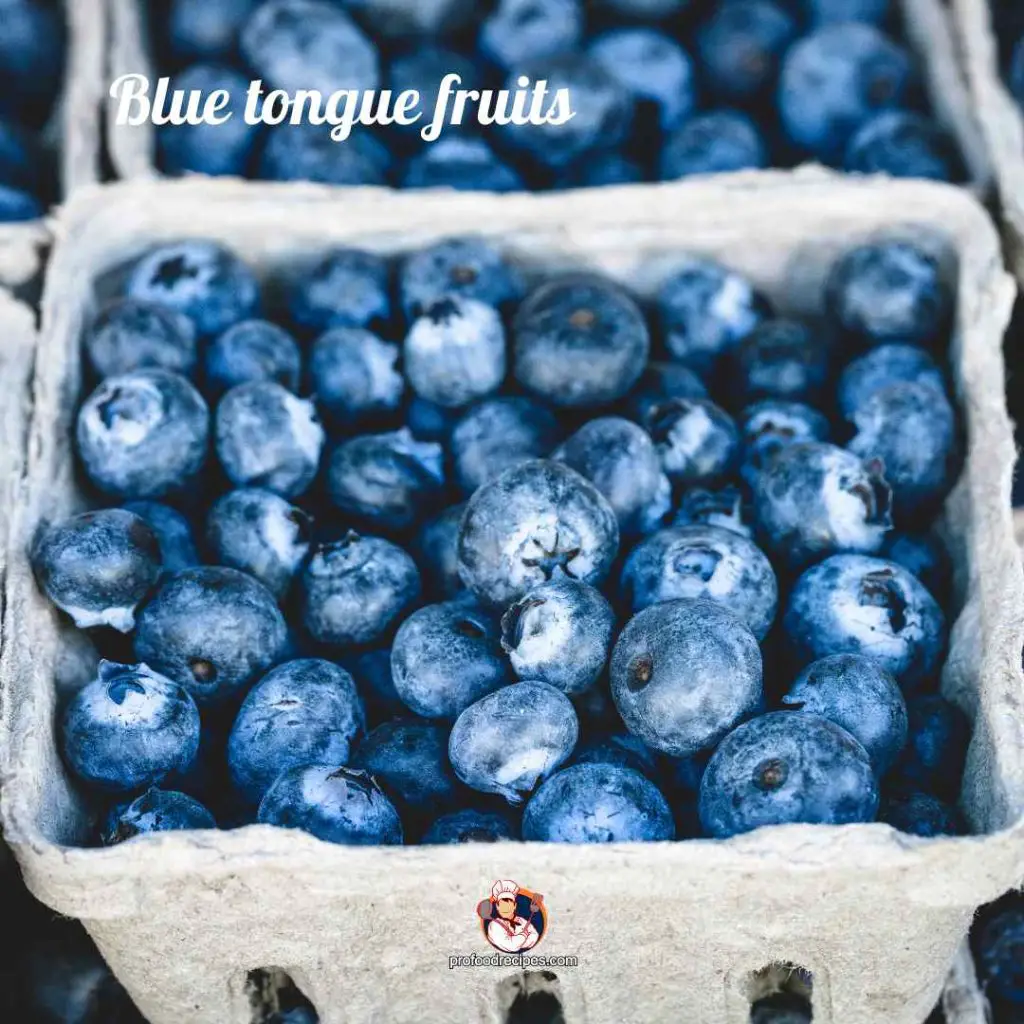
Blue tongue fruit emerges from ornamental bushes with red branches and fragrant purple flowers. These give way to sweet blue-black berries that stain tongues purple-blue—a favorite with kids.
Renowned as bush tucker, it also holds worldwide medicinal use for wounds, toothaches, and stomach ailments. Its custard-like texture and chocolatey flavor are dessert delights.
FAQs
What is the Longest Fruit Name Beginning With B?
Indeed, among the fruits listed, the “Broadleaf Bramble Fruit” claims the title of the longest fruit name beginning with “B.” This lesser-known fruit belongs to the bramble family and produces small, flavorful berries. Exploring unique fruits like the broadleaf bramble can be a delightful journey of discovery and taste exploration.
What Are Some Vegetables That Start With a B?
Here is a list of some veggies that begin with the letter b:
· Bamboo shoots
· Banana squash
· Bai yor leaf
· Beets
· Bell peppers
· Beansprouts
· Broccoli rabe
Final Verdict
In the world of fruits, the selection of fruit that starts with b presents a rich tapestry of flavors and nutrients. Whether indulging in bananas’ potassium boost or reveling in blueberries’ antioxidant richness, these fruits offer an array of health benefits. The diverse bunch, including blackberries, berries, and beyond, delivers vitamins, fiber, and natural sweetness.
For an in-depth exploration of their nutritional profiles and advantages, I encourage you to dive into our comprehensive article. Discover how these fruits with b can contribute to your well-being and culinary enjoyment.
You May Also Like to Read:
- Foods That Start With D
- Foods That Start With O
- Food That Start With P
- Food That Start With R
- Foods That Start With G
- Foods That Start With H
- Foods That Start With W
- Foods That Start With Y

